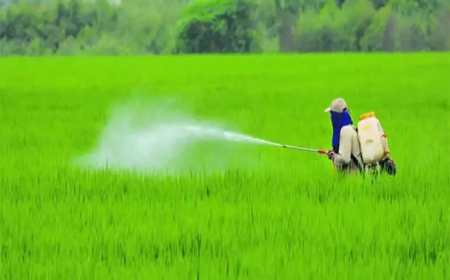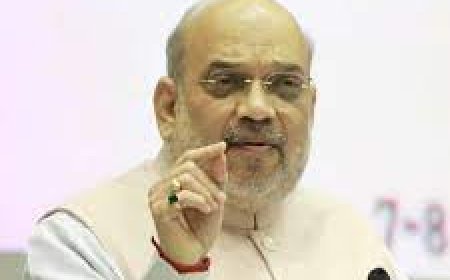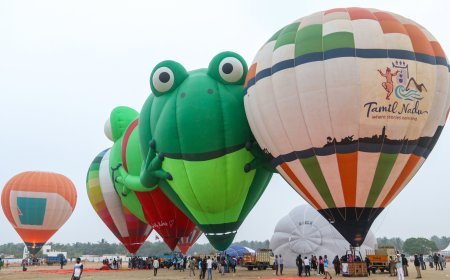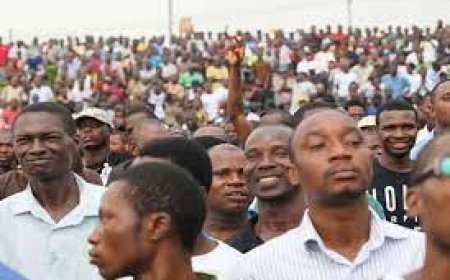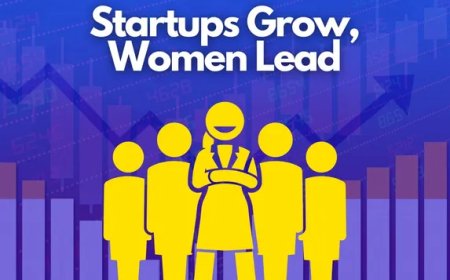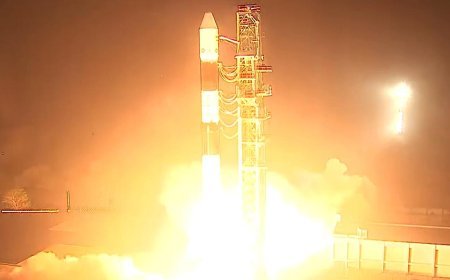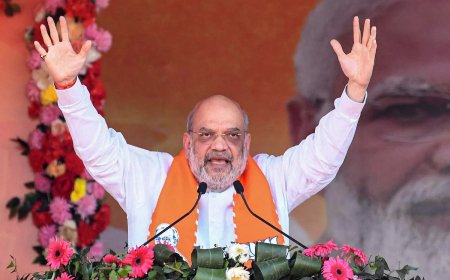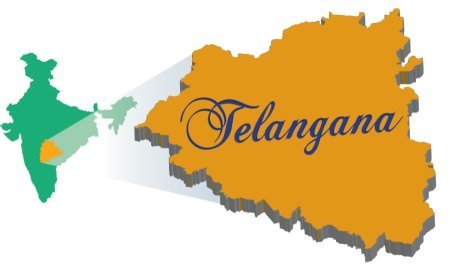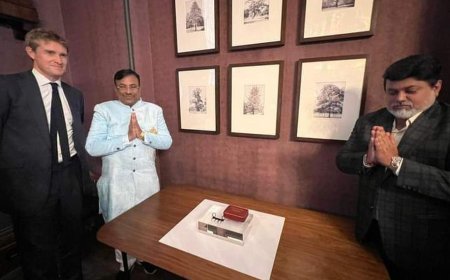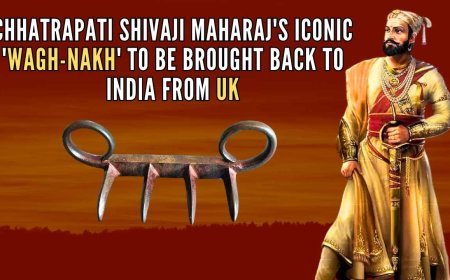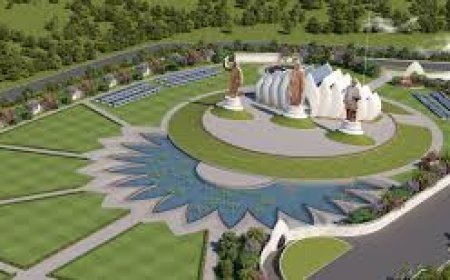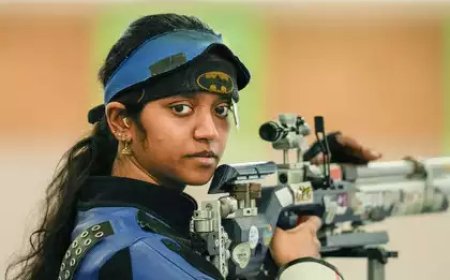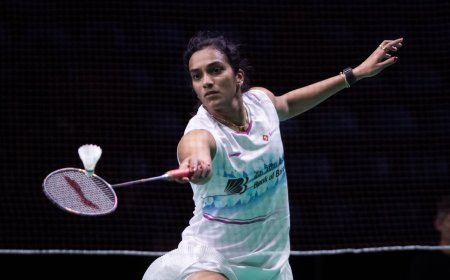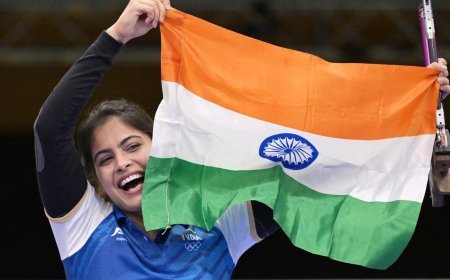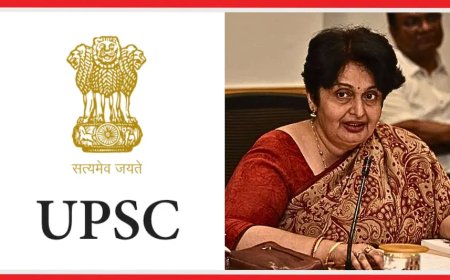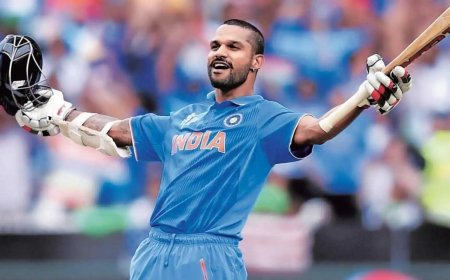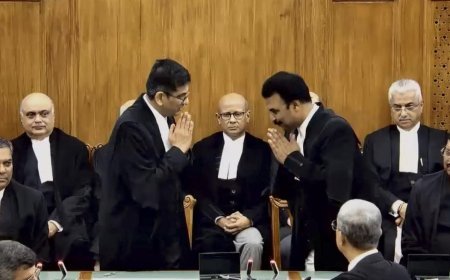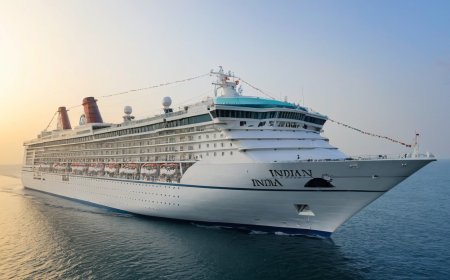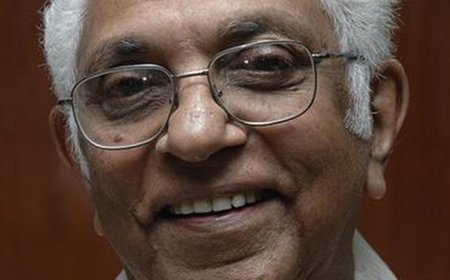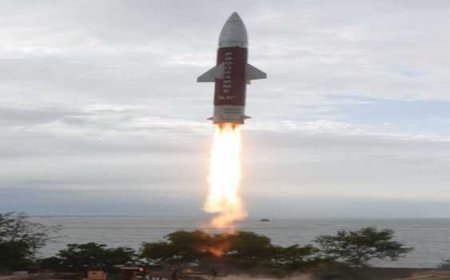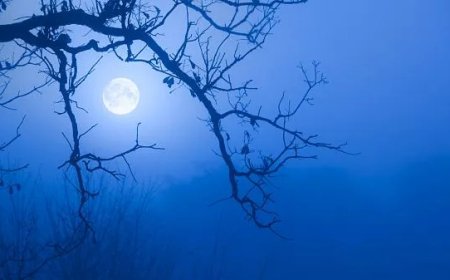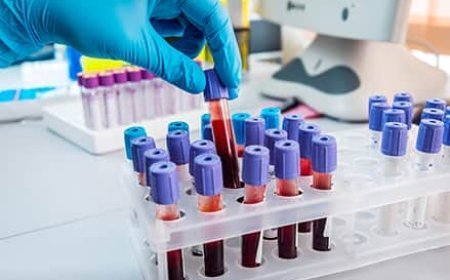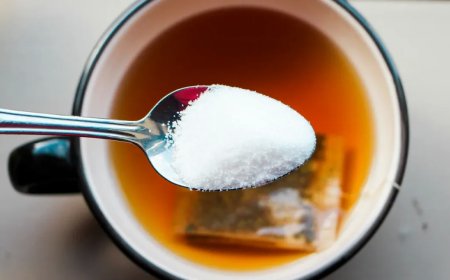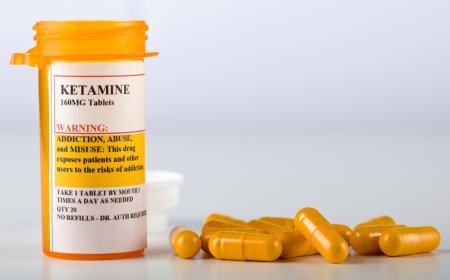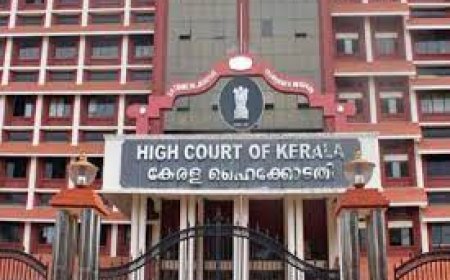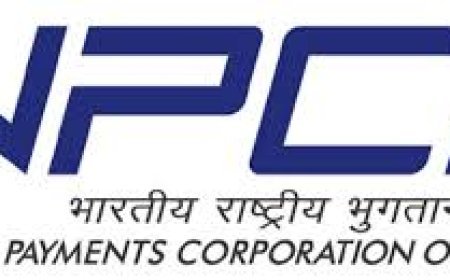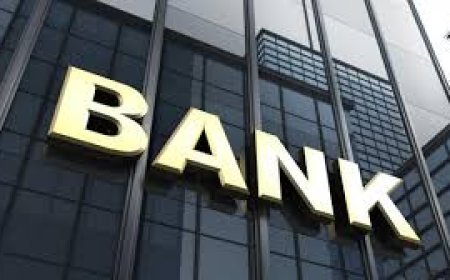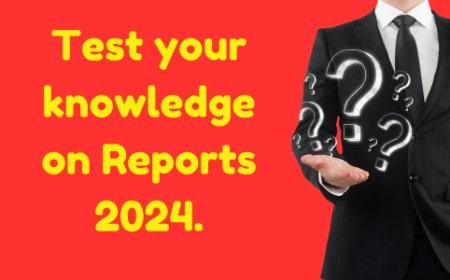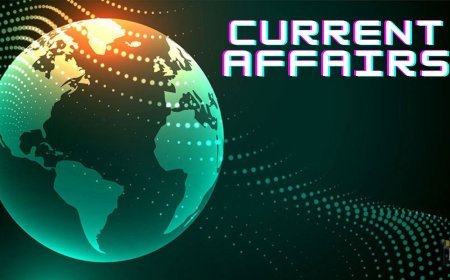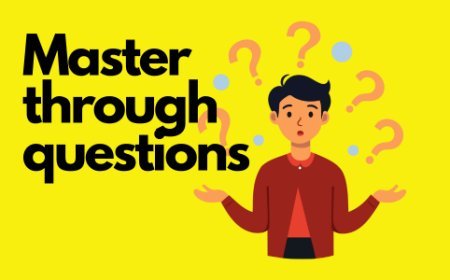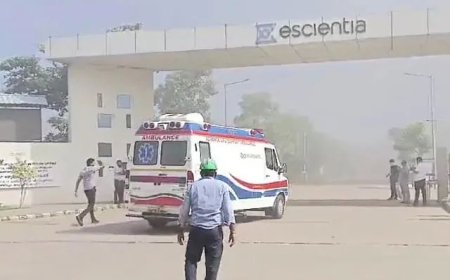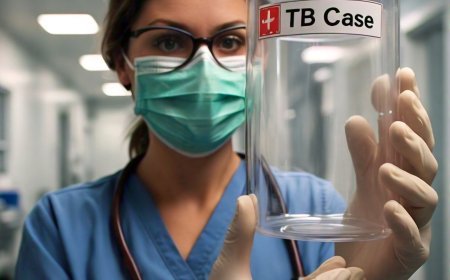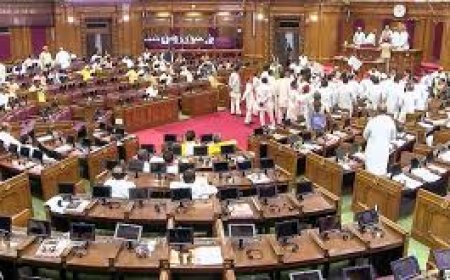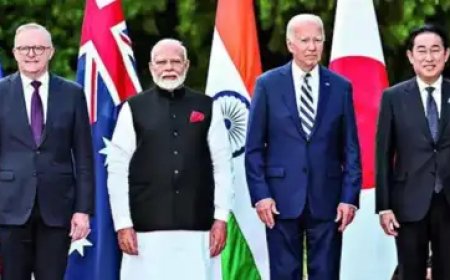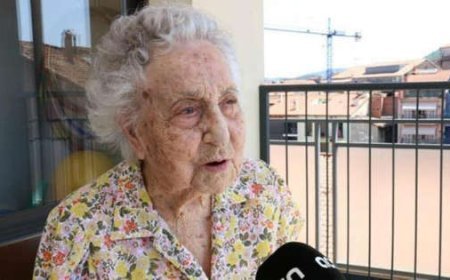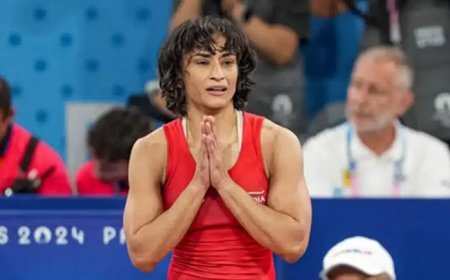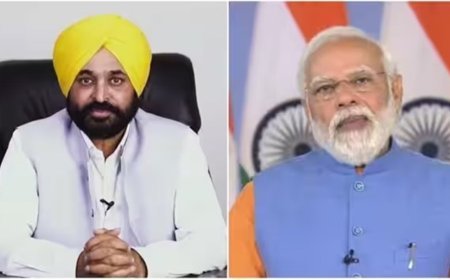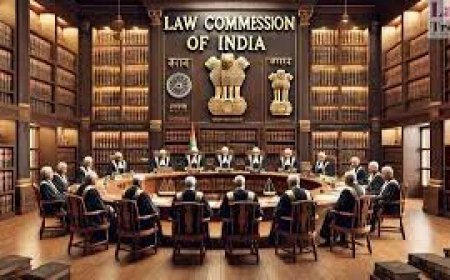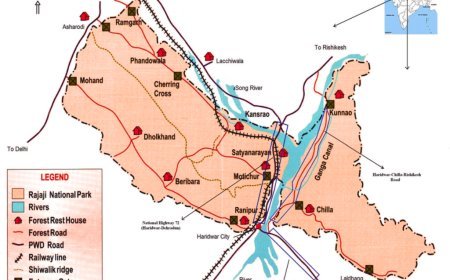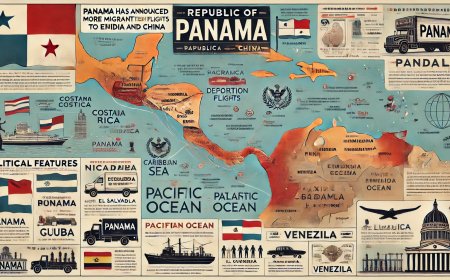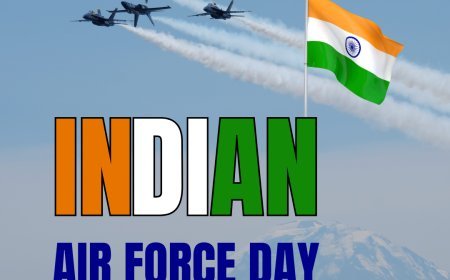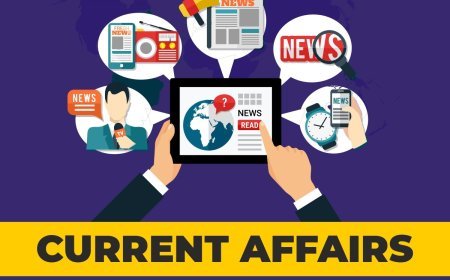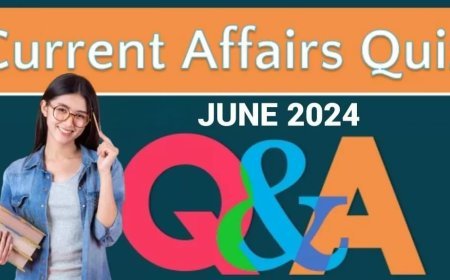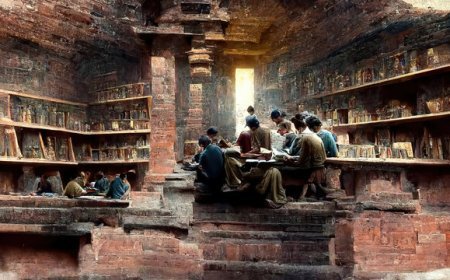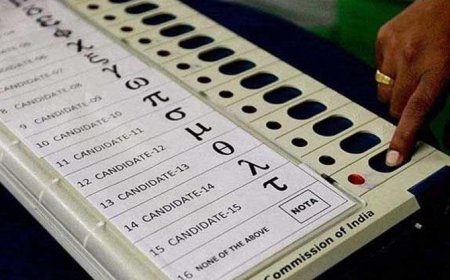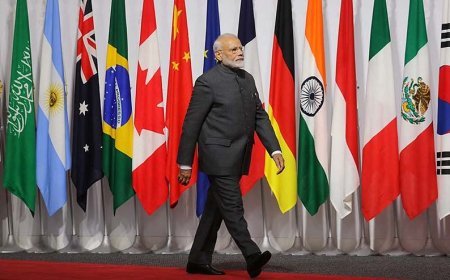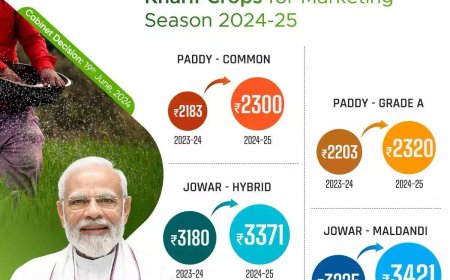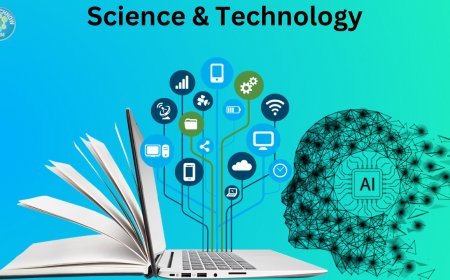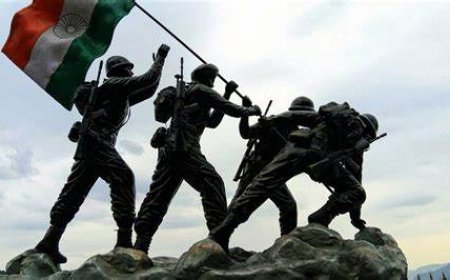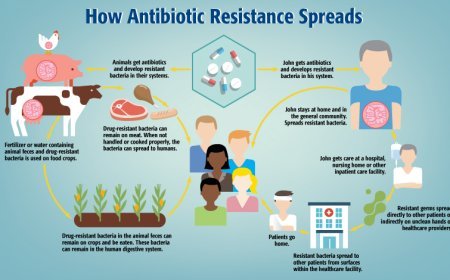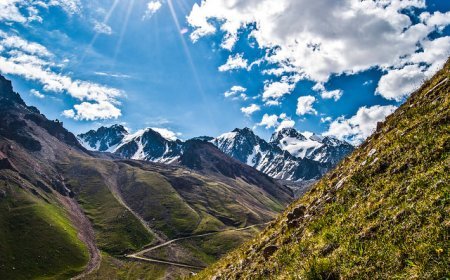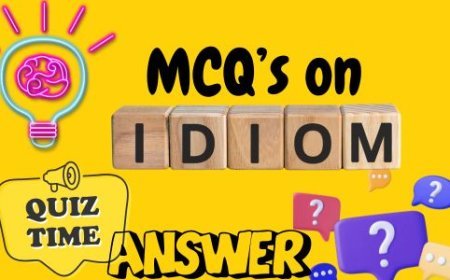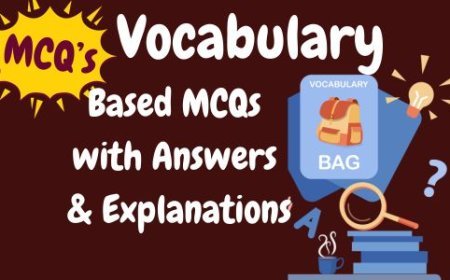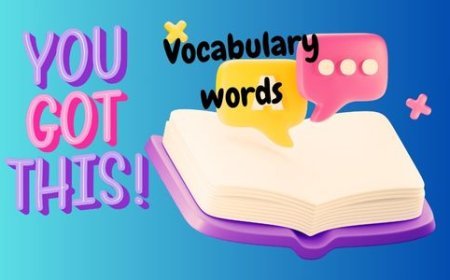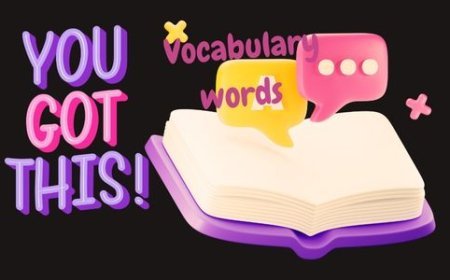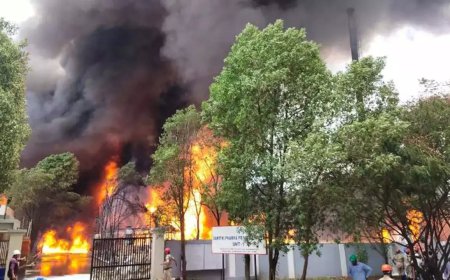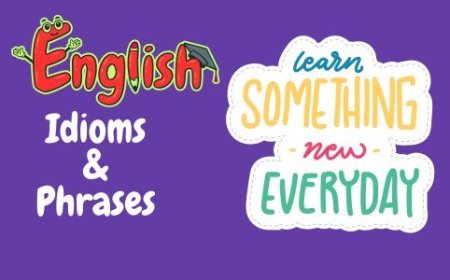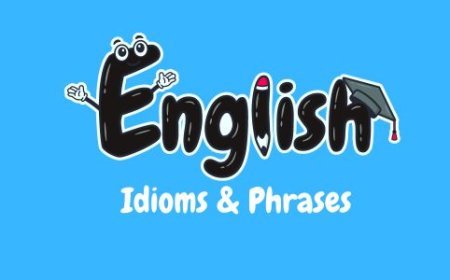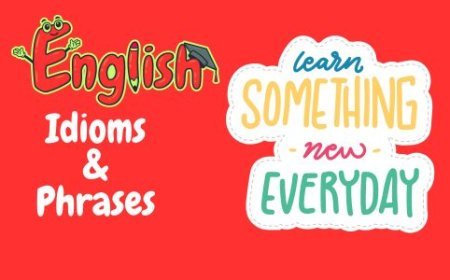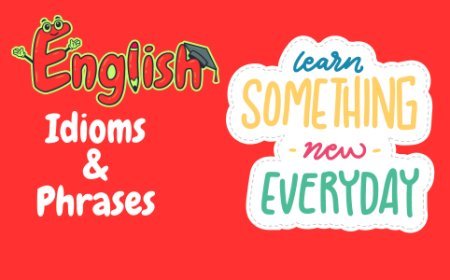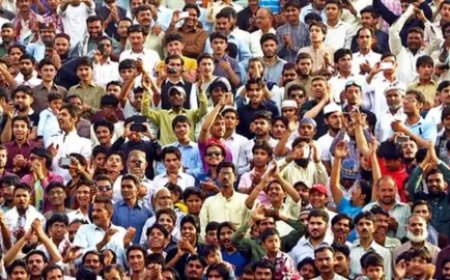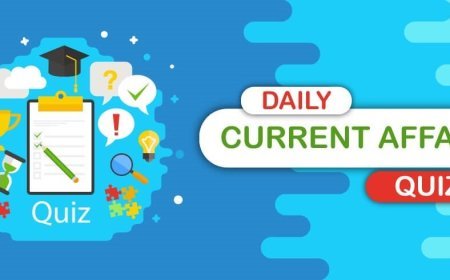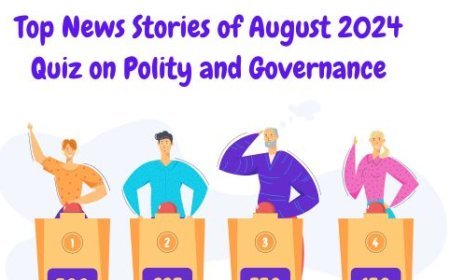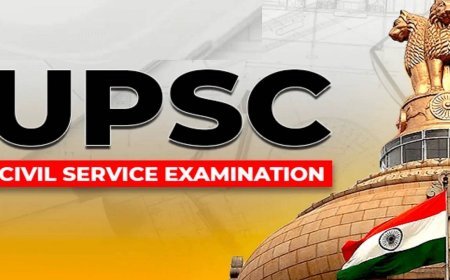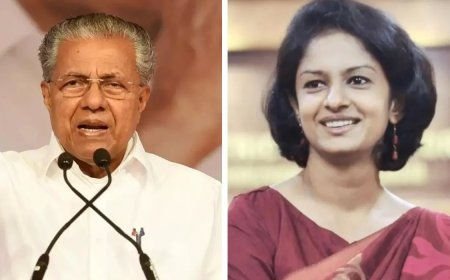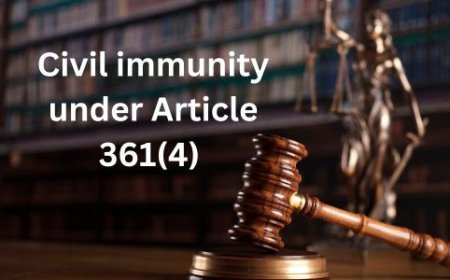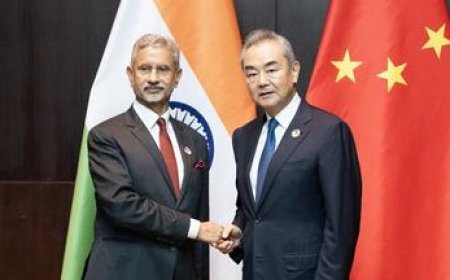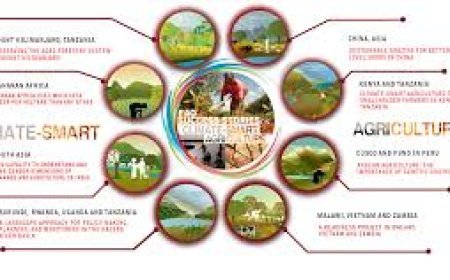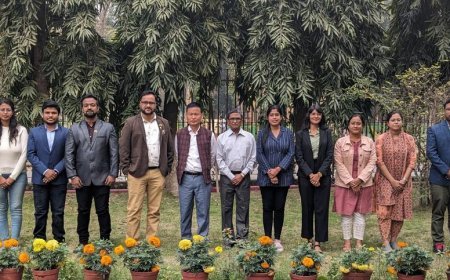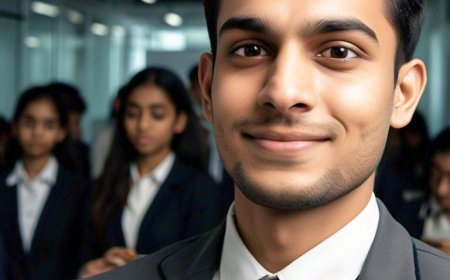Quiz of the Month June 2024
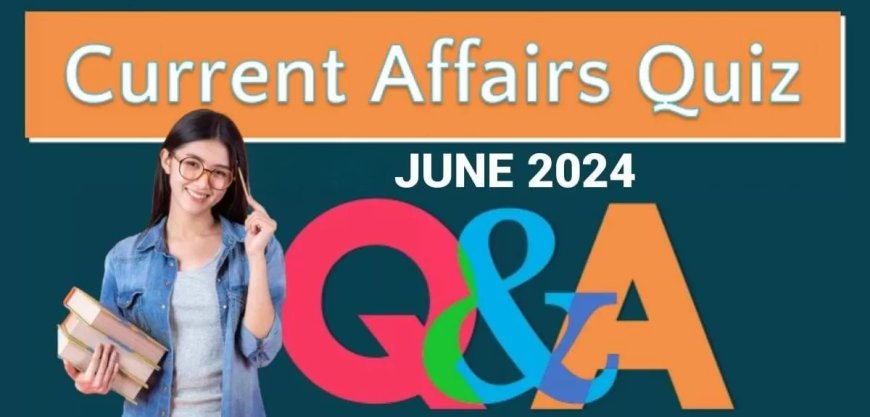
1. What is the maximum strength of the Lok Sabha as envisaged by the Indian Constitution?
A) 500
B) 550
C) 545
D) 552
Answer: b) 550
Explanation: The Indian Constitution envisages the maximum strength of the Lok Sabha to be 550 members.
2. Who appoints the Protem Speaker of the Lok Sabha?
A) THE PRIME MINISTER
B) THE CHIEF JUSTICE OF INDIA
C) THE PRESIDENT OF INDIA
D) THE VICEPRESIDENT OF INDIA
Answer: c) The President of India
Explanation: The Protem Speaker is appointed by the President of India to preside over the first meeting of the newly elected Lok Sabha until the Speaker is elected.
3. Which article of the Indian Constitution mentions the Speaker of the Lok Sabha?
A) ARTICLE 79
B) ARTICLE 93
C) ARTICLE 89
D) ARTICLE 81
Answer: b) Article 93
Explanation: Article 93 of the Indian Constitution deals with the election and duties of the Speaker and Deputy Speaker of the Lok Sabha.
4. Which law defined the Leader of Opposition in Parliament for the first time?
A) REPRESENTATION OF THE PEOPLE ACT, 1950
B) SALARY AND ALLOWANCES OF LEADERS OF OPPOSITION IN PARLIAMENT ACT, 1977
C) ANTIDEFECTION LAW
D) INDIAN PARLIAMENT (PROHIBITION OF OBSTRUCTION) ACT, 1986
Answer: b) Salary and Allowances of Leaders of Opposition in Parliament Act, 1977
Explanation: This Act defined the Leader of Opposition for the first time and laid down the conditions for recognition of the Leader of Opposition in Parliament.
5. What is the primary aim of the Artemis Accords?
A. To explore the depths of the Earth’s oceans
B. To regulate the use of artificial intelligence
C. To establish a framework for the peaceful exploration and utilization of the Moon and Mars
D. To promote international trade
Answer: c) To establish a framework for the peaceful exploration and utilization of the Moon and Mars
Explanation: The Artemis Accords are a series of agreements between the United States and other nations to ensure peaceful and cooperative space exploration, particularly focusing on the Moon and Mars.
6. Which project aims to streamline the migration process for Indian workers going abroad?
A. eMigrate Project
B. Global Mobility Initiative
C. International Worker Program
D. Bharat Emigration Scheme
Answer: a) eMigrate Project
Explanation: The eMigrate Project is an initiative by the Indian government to streamline and facilitate the migration process for Indian workers seeking employment abroad.
7. What is the primary function of the Infrastructure Investment Trust (InvIT) in India?
A. To manage public sector banks
B. To facilitate investment in infrastructure projects
C. To regulate the stock market
D. To provide loans to small businesses
Answer: b) To facilitate investment in infrastructure projects
Explanation: Infrastructure Investment Trusts (InvITs) are designed to facilitate investment in infrastructure projects by pooling funds from multiple investors.
8. Which sector in India receives priority sector lending according to RBI guidelines?
A. Real estate
B. Renewable energy
C. Information technology
D. Exportoriented industries
Answer: b) Renewable energy
Explanation: Priority sector lending guidelines by the RBI include sectors such as agriculture, micro, small, and medium enterprises, export credit, education, housing, social infrastructure, and renewable energy.
9. Under which Article of the Indian Constitution can the President's rule be imposed in a state on the grounds of the failure of constitutional machinery?
A. Article 352
B. Article 356
C. Article 360
D. Article 365
Answer: b) Article 356
Explanation: Article 356 of the Indian Constitution allows the President to impose President's rule in a state if he/she believes that the state government is unable to function according to the provisions of the Constitution.
10. Which of the following is not a function of the Speaker of the Lok Sabha?
A. Certifying money bills
B. Disqualifying members under the Tenth Schedule
C. Deciding the agenda of the House
D. Conducting elections to the Rajya Sabha
Answer: d) Conducting elections to the Rajya Sabha
Explanation: Conducting elections to the Rajya Sabha is not a function of the Speaker of the Lok Sabha. This is managed by the Election Commission of India.
11. The 'doctrine of pleasure' is applicable to which of the following?
A. The judges of the Supreme Court
B. The judges of the High Court
C. The members of the Union Public Service Commission
D. The civil servants
Answer: d) The civil servants
Explanation: The doctrine of pleasure, under Article 310 of the Indian Constitution, allows civil servants to hold office during the pleasure of the President or Governor.
12. Which body is responsible for conducting elections to the Panchayati Raj institutions in India?
A) STATE ELECTION COMMISSION
B) ELECTION COMMISSION OF INDIA
C) MINISTRY OF PANCHAYATI RAJ
D) STATE LEGISLATIVE ASSEMBLY
Answer: a) State Election Commission
Explanation: The State Election Commissions are responsible for
conducting elections to the Panchayati Raj institutions in India,
ensuring their independence from the Election Commission of India.
13. The WTO's Dispute Settlement Mechanism primarily aims to:
A) IMPOSE SANCTIONS ON NONCOMPLIANT COUNTRIES
B) RESOLVE TRADE DISPUTES BETWEEN MEMBER COUNTRIES
C) FACILITATE FINANCIAL AID TO DEVELOPING NATIONS
D) DRAFT NEW INTERNATIONAL TRADE LAWS
Answer: b) Resolve trade disputes between member countries
Explanation: The Dispute Settlement Mechanism of the WTO is designed to provide a forum for resolving trade disputes between member countries to ensure smooth and predictable international trade.
14. What is the primary focus of the Colombo Process?
A) MANAGING MIGRATION FOR EMPLOYMENT
B) STRENGTHENING MILITARY COOPERATION
C) ENHANCING REGIONAL TRADE AGREEMENTS
D) PROMOTING CULTURAL EXCHANGE PROGRAMS
Answer: a) Managing migration for employment
Explanation: The Colombo Process is a regional consultative process on the management of overseas employment and contractual labour for countries of origin in Asia.
15. What does the term 'priority sector lending' refer to in the context of Indian banking?
A) LOANS PROVIDED TO LARGE CORPORATIONS
B) LENDING TO SECTORS IDENTIFIED AS PRIORITY BY THE GOVERNMENT AND THE RBI
C) LOANS GIVEN TO FOREIGN COMPANIES OPERATING IN INDIA
D) EMERGENCY LOANS PROVIDED DURING FINANCIAL CRISES
Answer: b) Lending to sectors identified as priority by the government and the RBI
Explanation: Priority sector lending refers to the lending by banks to specific sectors identified as priority, such as agriculture, MSMEs, export credit, education, housing, social infrastructure, and renewable energy, to ensure adequate and timely credit to these sectors.
16. The Internationalisation of the Indian Rupee refers to:
A) MAKING THE RUPEE A GLOBAL RESERVE CURRENCY
B) ALLOWING FOREIGN COUNTRIES TO USE THE RUPEE FOR
INTERNATIONAL TRADE
C) PEGGING THE RUPEE TO THE US DOLLAR
D) REDUCING THE DEPENDENCY ON FOREIGN CURRENCIES FOR TRADE
Answer: b) Allowing foreign countries to use the rupee for international trade
Explanation: The internationalisation of the Indian Rupee involves allowing foreign countries to use the rupee for international trade and financial transactions, thus increasing its global acceptance and reducing dependency on other currencies like the US dollar.
17. Which treaty focuses on the conservation and sustainable use of
marine biodiversity in areas beyond national jurisdiction?
A) Antarctic Treaty
B) High Seas Biodiversity Treaty
C) Ramsar Convention
D) Convention On Biological Diversity
Answer: b) High Seas Biodiversity Treaty
Explanation: The High Seas Biodiversity Treaty aims to conserve and sustainably use marine biodiversity in areas beyond national jurisdiction, addressing the governance gaps in these regions.
18. The term 'Urban Heat Island' refers to:
A) an area in a city with high temperatures due to human
activities
B) A Coastal Region Experiencing Higher Temperatures Due To
Climate Change
C) A Volcanic Island That Causes Urban Areas To Heat Up
D) An Urban Area Surrounded By Cooler Rural Areas
Answer: a) An area in a city with high temperatures due to human
activities
Explanation: An Urban Heat Island (UHI) is an urban area that experiences higher temperatures than its rural surroundings due to human activities, such as construction, transportation, and industrial processes, which generate heat.
19. Quantum supremacy refers to:
A) The Superiority of Quantum Mechanics Over Classical
Mechanics
B) The Ability of Quantum Computers to Solve Problems That
Classical Computers Cannot
C) The Dominance of Quantum Physics in Modern Technology
D) The Supremacy of Quantum Particles In The Universe
Answer: b) The ability of quantum computers to solve problems that classical computers cannot
Explanation: Quantum supremacy is the point at which quantum computers can perform calculations that are infeasible for classical computers, demonstrating their superior computational power.
20. Which of the following is NOT a feature of the James Webb Space Telescope?
A) Observing Distant Galaxies and Exoplanets
B) Operating Primarily in the Infrared Spectrum
C) Replacing the Hubble Space Telescope in Low Earth Orbit
D) Positioned at the Second Lagrange Point (L2)
Answer: c) Replacing the Hubble Space Telescope in low Earth orbit
Explanation: The James Webb Space Telescope is positioned at the second Lagrange point (L2) and operates primarily in the infrared spectrum to observe distant galaxies and exoplanets, but it does not replace the Hubble Space Telescope in low Earth orbit.
21. The 'Exercise Red Flag' is associated with:
A) NAVAL WARFARE SIMULATIONS
B) COUNTERTERRORISM DRILLS
C) AIRTOAIR COMBAT TRAINING EXERCISES
D) CYBERSECURITY OPERATIONS
Answer: c) Airtoair combat training exercises
Explanation: Exercise Red Flag is a premier airtoair combat training exercise hosted by the United States Air Force, involving various air forces worldwide to enhance combat readiness and interoperability.
22. The term 'Nagastra1' refers to:
A) an advanced missile defense system
B) a nextgeneration fighter aircraft
C) an antitank guided missile
D) a satellite surveillance system
Answer: c) An antitank guided missile
Explanation: Nagastra1 is an advanced antitank guided missile developed to enhance the antiarmor capabilities of the armed forces.
23. The Kerala Migration Survey primarily focuses on:
A) tracking internal migration within kerala
b) studying the impact of international migration on kerala
c) analysing ruraltourban migration trends in india
d) assessing the effects of climate changeinduced
migration
Answer: b) Studying the impact of international migration on Kerala
Explanation: The Kerala Migration Survey studies the impact of international migration on Kerala, focusing on the socioeconomic effects of remittances and the demographic changes due to migration.
24. What is the primary goal of the National Forensic Infrastructure
Enhancement Scheme (NFIES)?
a) to build new forensic labs across india
b) to enhance the quality and capacity of existing forensic infrastructure
c) to train law enforcement in forensic techniques
d) to develop new forensic technologies
Answer: b) To enhance the quality and capacity of existing forensic infrastructure
Explanation: The NFIES aims to improve the quality and capacity of existing forensic infrastructure to support the criminal justice system with better and faster forensic analysis.
25. The Raja Parba celebration is associated with which Indian state?
A) RAJASTHAN
B) WEST BENGAL
C) ODISHA
D) GUJARAT
Answer: c) Odisha
Explanation: Raja Parba is a traditional festival celebrated in Odisha, marking the beginning of the agricultural year and the onset of the monsoon.
26. Nalanda University, an ancient center of learning, was located in
which presentday Indian state?
A) UTTAR PRADESH
B) BIHAR
C) MADHYA PRADESH
D) WEST BENGAL
Answer: b) Bihar
Explanation: Nalanda University, an ancient center of learning and a renowned Buddhist monastery, was located in presentday Bihar, India.
27. Which of the following Acts was introduced to prevent unfair
means during public examinations in India?
A. PUBLIC EXAMINATIONS (PREVENTION OF UNFAIR MEANS) ACT – 2024
B. PREVENTION OF CORRUPTION ACT, 1988
C. EXAMINATION MALPRACTICE ACT, 2010
D. RIGHT TO EDUCATION ACT, 2009
Answer: a) Public Examinations (Prevention of Unfair Means) Act –
2024
Explanation: The Public Examinations (Prevention of Unfair Means) Act – 2024 was introduced to prevent the use of unfair means during public examinations and ensure their integrity and fairness.
28.The Doctrine of Merger in Indian judiciary is intended to:
A) MERGE THE FUNCTIONS OF EXECUTIVE AND JUDICIARY
B) MERGE LOWER COURT JUDGMENTS WITH HIGHER COURT
JUDGMENTS
C) MERGE STATE LAWS WITH CENTRAL LAWS
D) MERGE CRIMINAL AND CIVIL LAW PROCEDURES
Answer: b) Merge lower court judgments with higher court judgments
Explanation: The Doctrine of Merger holds that when a higher court passes an order, the order passed by the lower court gets merged with the order of the higher court, maintaining judicial decorum and propriety.
29. What is the primary objective of the Initiative on Critical and
Emerging Technology (iCET)?
A) TO REGULATE EMERGING TECHNOLOGIES
B) TO PROMOTE GLOBAL TRADE IN TECHNOLOGY
C) TO FOSTER COLLABORATION IN CRITICAL AND EMERGING
TECHNOLOGIES BETWEEN NATIONS
D) TO DEVELOP NEW MILITARY TECHNOLOGIES
Answer: c) To foster collaboration in critical and emerging
technologies between nations
Explanation: The Initiative on Critical and Emerging Technology (iCET)
aims to promote international collaboration in developing and deploying critical and emerging technologies.
30. The 'Five Eyes Alliance' is an intelligencesharing network that
includes which countries?
A) USA, UK, CANADA, AUSTRALIA, NEW ZEALAND
B) USA, RUSSIA, CHINA, INDIA, JAPAN
C) UK, FRANCE, GERMANY, ITALY, SPAIN
D) USA, BRAZIL, SOUTH AFRICA, INDIA, AUSTRALIA
Answer: a) USA, UK, Canada, Australia, New Zealand
Explanation: The Five Eyes Alliance is an intelligencesharing network that includes the USA, UK, Canada, Australia, and New Zealand,
focusing on joint intelligence operations and information sharing.
31. The Open Network for Digital Commerce (ONDC) in India aims to:
a. PROMOTE DIGITAL PAYMENTS ACROSS RURAL AREAS
b. CREATE A UNIFIED DIGITAL PLATFORM FOR ECOMMERCE
c. PROVIDE LOANS TO SMALL AND MEDIUM ENTERPRISES
d. DEVELOP BLOCKCHAIN TECHNOLOGY FOR FINANCIAL TRANSACTIONS
Answer: b) Create a unified digital platform for ecommerce
Explanation: The Open Network for Digital Commerce (ONDC) aims to democratize digital commerce by creating a unified digital platform that connects buyers and sellers, enhancing market access and reducing monopolistic practices.
32. Which organization is responsible for the household consumption expenditure survey in India?
a. NATIONAL STATISTICAL OFFICE (NSO)
b. RESERVE BANK OF INDIA (RBI)
c. MINISTRY OF FINANCE
d. NITI AAYOG
Answer : a) National Statistical Office (NSO)
Explanation: The National Statistical Office (NSO) is responsible for conducting the household consumption expenditure survey in India, providing data on spending patterns, consumption habits, and living standards.
33.Which of the following treaties aims to ensure the conservation and sustainable use of marine biodiversity in areas beyond national jurisdiction?
a. HIGH SEAS BIODIVERSITY TREATY
b. ANTARCTIC TREATY
c. CONVENTION ON BIOLOGICAL DIVERSITY
d. RAMSAR CONVENTION
Answer: a) High Seas Biodiversity Treaty
Explanation: The High Seas Biodiversity Treaty focuses on the conservation and sustainable use of marine biodiversity in areas beyond national jurisdiction, addressing governance gaps in these regions.
34. Urban water crises are primarily caused by:
a. LACK OF RAINFALL
b. POOR WATER MANAGEMENT AND INFRASTRUCTURE
c. EXCESSIVE USE OF WATER FOR AGRICULTURE
d. HIGH INDUSTRIAL WATER CONSUMPTION
Answer: b) Poor water management and infrastructure
Explanation: Urban water crises are primarily caused by poor water management and infrastructure, leading to inadequate supply, wastage, and contamination of water resources in urban areas.
35. Nanotechnology, as a field, primarily deals with:
a. THE STUDY OF MICROSCOPIC ORGANISMS
b. THE MANIPULATION OF MATTER ON AN ATOMIC AND MOLECULAR SCALE
c. THE DEVELOPMENT OF NEW CHEMICAL COMPOUNDS
d. THE EXPLORATION OF OUTER SPACE
Answer: b) The manipulation of matter on an atomic and molecular scale
Explanation: Nanotechnology involves the manipulation of matter on an atomic and molecular scale, enabling the creation of new materials and devices with unique properties and applications.
36. HighAltitude Platform Stations (HAPS) are primarily used for:
a. DEEPSEA EXPLORATION
b. SPACE MISSIONS
c. TELECOMMUNICATIONS AND SURVEILLANCE
d. RENEWABLE ENERGY GENERATION
Answer: c) Telecommunications and surveillance
Explanation: HighAltitude Platform Stations (HAPS) are used for telecommunications and surveillance, providing connectivity and monitoring capabilities from high altitudes, often in remote or underserved areas.
37. The term 'Cyberspace Warfare' refers to:
a. Physical combat using advanced technology
b. Hostile actions in cyberspace to disrupt, damage, or control information systems
c. The use of drones in military operations
d. Underwater combat techniques
e. Answer: b) Hostile actions in cyberspace to disrupt, damage, or control information systems
f. Explanation: Cyberspace Warfare involves hostile actions in cyberspace aimed at disrupting, damaging, or controlling information systems, often to gain a strategic advantage.
38. The 'Tarang Shakti 2024' exercise is conducted by which branches of the Indian military?
a. ARMY AND NAVY
b. NAVY AND AIR FORCE
c. AIR FORCE AND ARMY
d. ALL THREE BRANCHES: ARMY, NAVY, AND AIR FORCE
Answer: d) All three branches: Army, Navy, and Air Force
Explanation: Tarang Shakti 2024 is a joint military exercise conducted by the Indian Army, Navy, and Air Force to enhance interoperability and operational readiness among the three branches.
39. The term 'Antimicrobial Resistance (AMR)' refers to:
a. THE BODY'S RESISTANCE TO ANTIBIOTICS
b. THE RESISTANCE OF MICROBES TO ANTIMICROBIAL DRUGS
c. THE DEVELOPMENT OF NEW ANTIMICROBIAL DRUGS
d. THE USE OF ANTIMICROBIALS IN AGRICULTURE
Answer: b) The resistance of microbes to antimicrobial drugs
Explanation: Antimicrobial Resistance (AMR) occurs when microbes develop resistance to antimicrobial drugs, making infections harder to treat and increasing the risk of disease spread, severe illness, and death.
40. The 'Poori Padhai Desh Ki Bhalai Campaign' focuses on:
a. IMPROVING AGRICULTURAL PRACTICES
b. ENHANCING HEALTHCARE INFRASTRUCTURE
c. PROMOTING EDUCATION AND LITERACY
d. ENCOURAGING ENTREPRENEURSHIP
Answer: c) Promoting education and literacy
Explanation: The Poori Padhai Desh Ki Bhalai Campaign aims to promote education and literacy, emphasizing the importance of complete education for the overall betterment of the country.
41. The 'Kheer Bhawani Mela' is a significant festival in which Indian state?
a. UTTAR PRADESH
b. MAHARASHTRA
c. JAMMU AND KASHMIR
d. PUNJAB
Answer: c) Jammu and Kashmir
Explanation: The Kheer Bhawani Mela is a significant festival celebrated in Jammu and Kashmir, dedicated to the goddess Kheer Bhawani, and attracts devotees from across the region.
42. Which Indian city has been designated as a 'World Craft City' by the World Craft Council?
a. JAIPUR
b. SRINAGAR
c. HYDERABAD
d. CHENNAI
Answer: b) Srinagar
Explanation: Srinagar has been designated as a 'World Craft City' by the World Craft Council, recognizing its rich tradition and craftsmanship in arts and crafts.
43. The Atal Mission for Rejuvenation and Urban Transformation (AMRUT) aims to:
a. IMPROVE RURAL INFRASTRUCTURE
b. DEVELOP URBAN AMENITIES AND INFRASTRUCTURE
c. PROMOTE RENEWABLE ENERGY PROJECTS
d. ENHANCE AGRICULTURAL PRODUCTIVITY
Answer: b) Develop urban amenities and infrastructure
Explanation: The Atal Mission for Rejuvenation and Urban
Transformation (AMRUT) aims to develop urban amenities and infrastructure, focusing on improving water supply, sewerage, urban transport, and green spaces.
44. The Digital Health Incentive (DHI) Scheme is intended to:
a. PROVIDE HEALTH INSURANCE TO ALL CITIZENS
b. ENCOURAGE THE ADOPTION OF DIGITAL HEALTH SOLUTIONS
c. BUILD NEW HOSPITALS IN RURAL AREAS
d. PROMOTE TRADITIONAL MEDICINE PRACTICES
Answer: b) Encourage the adoption of digital health solutions
Explanation: The Digital Health Incentive (DHI) Scheme is designed to encourage the adoption of digital health solutions, improving healthcare delivery and access through technology.
45. The 'Global Gender Gap Report' is published by:
a. UNITED NATIONS
b. WORLD ECONOMIC FORUM
c. INTERNATIONAL LABOUR ORGANIZATION
d. WORLD BANK
Answer: b) World Economic Forum
Explanation: The Global Gender Gap Report is published by the World Economic Forum, measuring gender equality across countries based on economic, educational, health, and political criteria.
46. The 'State of India’s Environment' report is produced by which organization?
a. CENTRE FOR SCIENCE AND ENVIRONMENT (CSE)
b. MINISTRY OF ENVIRONMENT, FOREST AND CLIMATE CHANGE
c. UNITED NATIONS ENVIRONMENT PROGRAMME
d. WORLD WILDLIFE FUND
Answer: a) Centre for Science and Environment (CSE)
Explanation: The 'State of India’s Environment' report is produced by the Centre for Science and Environment (CSE), providing comprehensive insights into environmental issues and policies in India.
47. Ahilyabai Holkar was a renowned ruler of which Indian state?
a. MAHARASHTRA
b. RAJASTHAN
c. MADHYA PRADESH
d. GUJARAT
Answer: c) Madhya Pradesh
Explanation: Ahilyabai Holkar was a renowned ruler of the Malwa region in presentday Madhya Pradesh, known for her administrative skills, philanthropy, and contributions to infrastructure and temple construction.
48. Sukumar Sen is known for his role in:
a. INDIAN INDEPENDENCE MOVEMENT
b. FIRST CHIEF ELECTION COMMISSIONER OF INDIA
c. FOUNDING THE INDIAN NATIONAL CONGRESS
d. LEADING THE QUIT INDIA MOVEMENT
Answer: b) First Chief Election Commissioner of India
Explanation: Sukumar Sen was the first Chief Election Commissioner of India, overseeing the first general elections of independent India and laying the foundation for a robust electoral system.
49. The concept of 'Living Will' in India relates to:
a. PROPERTY DISTRIBUTION AFTER DEATH
b. ADVANCE DIRECTIVE FOR MEDICAL TREATMENT
c. FINANCIAL MANAGEMENT FOR MINORS
d. LEGAL GUIDELINES FOR WILLS AND TESTAMENTS
Answer: b) Advance directive for medical treatment
Explanation: A 'Living Will' is a written advance directive by which a person specifies what actions should be taken for their health if they are no longer able to make decisions due to illness or incapacity.
50. What is the primary function of the Quality Council of India (QCI)?
a. PROMOTING HIGHER EDUCATION
b. ENSURING QUALITY STANDARDS IN VARIOUS SECTORS
c. REGULATING FINANCIAL MARKETS
d. OVERSEEING NATIONAL DEFENSE POLICIES
Answer: b) Ensuring quality standards in various sectors
Explanation: The Quality Council of India (QCI) is responsible for establishing and operating national accreditation structure and ensuring quality standards in various sectors including healthcare, education, and infrastructure.
51. The 'BRICS+' initiative aims to:
a. EXPAND THE MEMBERSHIP OF BRICS TO INCLUDE ADDITIONAL EMERGING ECONOMIES
b. DEVELOP NEW TRADE ROUTES IN ASIA
c. ENHANCE MILITARY COOPERATION AMONG BRICS COUNTRIES
d. CREATE A COMMON CURRENCY FOR BRICS NATIONS
Answer: a) Expand the membership of BRICS to include additional emerging economies
Explanation: The 'BRICS+' initiative aims to expand the membership of the BRICS group (Brazil, Russia, India, China, South Africa) by including other emerging economies to increase its global influence.
52.The WHO Pandemic Preparedness Treaty focuses on:
a. DEVELOPING VACCINES FOR ALL KNOWN VIRUSES
b. ESTABLISHING A GLOBAL FRAMEWORK FOR PANDEMIC PREVENTION, PREPAREDNESS, AND RESPONSE
c. PROVIDING FINANCIAL AID TO PANDEMICAFFECTED COUNTRIES
d. REGULATING INTERNATIONAL TRAVEL DURING PANDEMICS
Answer: b) Establishing a global framework for pandemic prevention, preparedness, and response
Explanation: The WHO Pandemic Preparedness Treaty aims to establish a global framework to ensure that the world is better prepared for and can respond more effectively to future pandemics.
53. What is the purpose of the Infrastructure Investment Trust (InvIT) in India?
a. TO FACILITATE INVESTMENT IN INFRASTRUCTURE PROJECTS
b. TO MANAGE PUBLIC SECTOR BANKS
c. TO REGULATE THE STOCK MARKET
d. TO PROVIDE LOANS TO SMALL BUSINESSES
Answer: a) To facilitate investment in infrastructure projects
Explanation: Infrastructure Investment Trusts (InvITs) are designed to facilitate investment in infrastructure projects by pooling funds from multiple investors, thereby increasing the availability of capital for such projects.
54. The concept of 'Priority Sector Lending' in India is aimed at:
a. Providing loans to large corporations
b. Ensuring adequate credit to sectors identified as priority by the government and rbi
c. Supporting foreign investments in india
d. Financing government infrastructure projects
Answer: b) Ensuring adequate credit to sectors identified as priority by the government and RBI
Explanation: Priority Sector Lending ensures that certain sectors such as agriculture, MSMEs, export credit, education, housing, social infrastructure, and renewable energy receive adequate and timely credit.
55. The term 'EcoSensitive Zones' refers to:
a. Areas with high levels of pollution
b. Regions around protected areas to minimize the impact of human activities
c. Zones prone to natural disasters
d. Urban areas with strict environmental regulations
Answer: b) Regions around protected areas to minimize the impact of human activities
Explanation: EcoSensitive Zones (ESZs) are regions around protected areas like national parks and wildlife sanctuaries aimed at creating a buffer zone to minimize the impact of human activities on the environment.
56. Which treaty focuses on the protection and sustainable use of Antarctica?
a. ANTARCTIC TREATY
b. HIGH SEAS BIODIVERSITY TREATY
c. RAMSAR CONVENTION
d. CONVENTION ON BIOLOGICAL DIVERSITY
Answer: a) Antarctic Treaty
Explanation: The Antarctic Treaty ensures that Antarctica is used for peaceful purposes only, prohibits military activity, and promotes scientific cooperation and environmental protection in the region.
57.Supercomputers are primarily used for:
a. WORD PROCESSING
b. COMPLEX SCIENTIFIC CALCULATIONS AND SIMULATIONS
c. PERSONAL ENTERTAINMENT
d. INTERNET BROWSING
e. Answer: b) Complex scientific calculations and simulations
f. Explanation: Supercomputers are designed for performing complex scientific calculations and simulations, such as weather forecasting, quantum mechanics, and molecular modelling.
58. What is the primary advantage of nanotechnology in medicine?
a. Development of larger medical devices
b. Enhanced imaging and diagnostics
c. Slower drug delivery
d. Higher costs of treatments
Answer: b) Enhanced imaging and diagnostics
Explanation: Nanotechnology in medicine offers advantages such as enhanced imaging, improved diagnostics, targeted drug delivery, and the potential to treat diseases at the cellular and molecular levels.
59. The 'Iskander Missile System' is associated with which country?
a. INDIA
b. USA
c. RUSSIA
d. CHINA
Answer: c) Russia
Explanation: The Iskander Missile System is a mobile shortrange ballistic missile system developed by Russia, capable of carrying conventional and nuclear warheads.
60. 'Jimex – 24' refers to a military exercise between which two countries?
a. INDIA AND JAPAN
b. INDIA AND USA
c. INDIA AND RUSSIA
d. INDIA AND AUSTRALIA
Answer: a) India and Japan
Explanation: Jimex – 24 is a bilateral naval exercise between India and Japan, aimed at enhancing maritime cooperation and interoperability between the two navies.
61. The term 'Human Trafficking' refers to:
a. LEGAL MIGRATION FOR EMPLOYMENT
b. ILLEGAL TRADE OF HUMANS FOR EXPLOITATION
c. VOLUNTARY EXCHANGE OF SERVICES
d. INTERNATIONAL TRAVEL FOR LEISURE
Answer: b) Illegal trade of humans for exploitation
Explanation: Human trafficking involves the illegal trade of humans, primarily for forced labour, sexual slavery, and exploitation, and is considered a serious violation of human rights.
62.The 'Safai Apnao, Bimaari Bhagao (SABB) Initiative' is aimed at:
e. PROMOTING CLEANLINESS AND HYGIENE
f. PROVIDING HEALTH INSURANCE
g. ENCOURAGING AGRICULTURAL PRACTICES
h. SUPPORTING SMALL BUSINESSES
i. Answer: a) Promoting cleanliness and hygiene
j. Explanation: The 'Safai Apnao, Bimaari Bhagao (SABB) Initiative' focuses on promoting cleanliness and hygiene to prevent diseases and improve public health.
62.The 'Annual Ambubachi Mela' is held in which Indian state?
a. WEST BENGAL
b. ODISHA
c. ASSAM
d. BIHAR
Answer: c) Assam
Explanation: The Annual Ambubachi Mela is a significant religious festival held at the Kamakhya Temple in Assam, celebrating the yearly menstruation course of the goddess Kamakhya.
63. The 'UNESCO ‘City of Literature’ title is given to cities that:
a. HAVE A RICH LITERARY HISTORY AND ACTIVE CONTEMPORARY LITERARY SCENE
b. ARE KNOWN FOR THEIR ANCIENT ARCHITECTURE
c. HOST MAJOR INTERNATIONAL TRADE FAIRS
d. HAVE SIGNIFICANT INDUSTRIAL DEVELOPMENT
Answer: a) Have a rich literary history and active contemporary literary scene
Explanation: The UNESCO ‘City of Literature’ title is awarded to cities with a rich literary history and an active contemporary literary scene, fostering a culture of reading and writing.
64. The Pradhan Mantri Awas Yojana (PMAY) aims to:
a. Provide Affordable Housing For All By 2022
b. Promote Higher Education
c. Enhance Healthcare Infrastructure
d. Develop Industrial Parks
Answer: a) Provide affordable housing for all by 2022
Explanation: The Pradhan Mantri Awas Yojana (PMAY) aims to provide affordable housing for all by 2022, targeting economically weaker sections, lowincome groups, and middleincome groups.
65. The CSIRAspire Scheme is focused on:
a. Supporting Scientific Research and Innovation
b. Providing Scholarships for Higher Education
c. Promoting Traditional Arts and Crafts
d. Developing Sports Infrastructure
e. Answer: a) Supporting scientific research and innovation
f. Explanation: The CSIRAspire Scheme aims to support scientific research and innovation by providing grants and resources to researchers and scientists for advanced research projects.
66. The 'Global Food Policy Report' is published by:
a. Food and Agriculture Organization (FAO)
b. World Food Programme (WFP)
c. International Food Policy Research Institute (IFPRI)
d. United Nations Development Programme (UNDP)
Answer: c) International Food Policy Research Institute (IFPRI)
Explanation: The 'Global Food Policy Report' is published by the International Food Policy Research Institute (IFPRI), providing analysis and insights on global food policy issues.
67. The 'World Wealth Report' is produced by which organization?
a. International Monetary Fund (IMF)
b. Capgemini and RBC Wealth Management
c. World Bank
d. United Nations
Answer: b) Capgemini and RBC Wealth Management
Explanation: The 'World Wealth Report' is produced by Capgemini and RBC Wealth Management, analyzing trends and developments in global wealth and the behavior of highnetworth individuals.
68. Mahatma Gandhi is best known for his role in:
a. Industrial Development in India
b. The Indian Independence Movement
c. Founding The Indian National Congress
d. Promoting Western Education in India
Answer: b) The Indian independence movement
Explanation: Mahatma Gandhi is best known for his leadership in the Indian independence movement, advocating for nonviolent resistance and civil disobedience to end British rule in India.
69. Dr. Syama Prasad Mookerjee is associated with which political
party?
a. Indian National Congress
b. Bharatiya Jana Sangh
c. Communist Party of India
d. All India Trinamool Congress
Answer: b) Bharatiya Jana Sangh
Explanation: Dr. Syama Prasad Mookerjee was the founder of the Bharatiya Jana Sangh, which later evolved into the Bharatiya Janata Party (BJP), and he played a significant role in Indian politics.
70. What is the primary purpose of the Post Office Act 2023?
a. To Regulate the Functioning of Private Courier Services
b. To Modernize and Improve the Efficiency of Postal Services
c. To Provide Subsidies for Postal Services in Rural Areas
d. To Integrate Postal Services with Banking Services
Answer: b) To modernize and improve the efficiency of postal services
Explanation: The Post Office Act 2023 aims to modernize and improve the efficiency of postal services, ensuring better delivery and service standards across the country.
71. Which article of the Indian Constitution provides for the removal of the Speaker of the Lok Sabha?
a. ARTICLE 93
b. ARTICLE 94
c. ARTICLE 96
d. ARTICLE 98
Answer: b) Article 94
Explanation: Article 94 of the Indian Constitution provides for the removal of the Speaker of the Lok Sabha by a resolution passed by a majority of all the then members of the House.
72. The 'eMigrate Project' is an initiative by India to:
a. Simplify the visa application process for foreign nationals
b. Streamline the migration process for indian workers going abroad
c. Promote tourism in India
d. Enhance international student exchange programs
Answer: b) Streamline the migration process for Indian workers going abroad
Explanation: The eMigrate Project is an initiative by the Indian government to streamline and facilitate the migration process for Indian workers seeking employment abroad, ensuring their safety and welfare.
73. The G7 Summit primarily focuses on:
a. Economic cooperation among emerging economies
b. Environmental conservation and climate change
c. Military alliances and Defence strategies
d. Economic and political cooperation among advanced economies
e. Answer: d) Economic and political cooperation among advanced economies
f. Explanation: The G7 Summit is a forum for economic and political cooperation among seven of the world's advanced economies, discussing global issues such as trade, security, and environmental policies.
74. What is the primary goal of the FinTech Sector in India?
a. To regulate traditional banking systems
b. To innovate and enhance financial services through technology
c. To promote agricultural financing
d. To provide government subsidies to startups
Answer: b) To innovate and enhance financial services through technology
Explanation: The FinTech Sector in India focuses on using technology to innovate and enhance financial services, making them more efficient, accessible, and userfriendly.
75.Which organization oversees the Internationalisation of the Indian Rupee?
a. RESERVE BANK OF INDIA (RBI)
b. MINISTRY OF FINANCE
c. SECURITIES AND EXCHANGE BOARD OF INDIA (SEBI)
d. WORLD BANK
Answer: a) Reserve Bank of India (RBI)
Explanation: The Reserve Bank of India (RBI) oversees the internationalization of the Indian Rupee, aiming to increase its global acceptance and use in international trade and financial transactions.
76. The term 'Urban Heat' refers to:
a. High temperatures in rural areas due to urbanization
b. Elevated temperatures in urban areas compared to their rural surroundings
c. Temperature variations in coastal regions
d. Heat waves in desert regions
Answer: b) Elevated temperatures in urban areas compared to their rural surroundings
Explanation: Urban Heat refers to the phenomenon where urban areas experience higher temperatures than their rural surroundings due to human activities, buildings, and infrastructure absorbing and reemitting heat.
77. The 'Burp Tax' is associated with:
a. TAX ON CARBON EMISSIONS FROM FACTORIES
b. TAX ON METHANE EMISSIONS FROM LIVESTOCK
c. TAX ON SUGARY BEVERAGES
d. TAX ON LUXURY GOODS
Answer: b) Tax on methane emissions from livestock
Explanation: The 'Burp Tax' refers to a tax on methane emissions from livestock, particularly cattle, aimed at reducing greenhouse gas emissions and mitigating climate change.
78.The primary advantage of Quantum Science and Technology is:
a. Developing new medical treatments
b. Enhancing computational power and security
c. Improving agricultural yields
d. Advancing space exploration
Answer: b) Enhancing computational power and security
Explanation: Quantum Science and Technology offers significant advantages in enhancing computational power, enabling the solving of complex problems, and improving security through quantum cryptography.
79. The term 'Supercomputers' refers to:
a. COMPUTERS DESIGNED FOR PERSONAL USE
b. COMPUTERS WITH ADVANCED GAMING CAPABILITIES
c. EXTREMELY POWERFUL COMPUTERS USED FOR COMPLEX CALCULATIONS AND SIMULATIONS
d. COMPUTERS USED IN EDUCATIONAL INSTITUTIONS
Answer: c) Extremely powerful computers used for complex calculations and simulations
Explanation: Supercomputers are extremely powerful computers designed for performing complex calculations and simulations, often used in scientific research, weather forecasting, and data analysis.
80. The 'Exercise Red Flag' is an international air combat exercise held in:
a. INDIA
b. USA
c. RUSSIA
d. CHINA
Answer: b) USA
Explanation: Exercise Red Flag is an international air combat training exercise hosted by the United States Air Force, involving various air forces worldwide to enhance combat readiness and interoperability.
81. The 'Nagastra1' is:
a. A SURFACETOAIR MISSILE SYSTEM
b. AN ANTITANK GUIDED MISSILE
c. A STEALTH FIGHTER AIRCRAFT
d. A NAVAL WARSHIP
Answer: b) An antitank guided missile
Explanation: Nagastra1 is an advanced antitank guided missile developed to enhance the antiarmor capabilities of the armed forces.
82.The term 'Antimicrobial Resistance (AMR)' refers to:
a. The body's resistance to antibiotics
b. The resistance of microbes to antimicrobial drugs
c. The development of new antimicrobial drugs
d. The use of antimicrobials in agriculture
Answer: b) The resistance of microbes to antimicrobial drugs
Explanation: Antimicrobial Resistance (AMR) occurs when microbes develop resistance to antimicrobial drugs, making infections harder to treat and increasing the risk of disease spread, severe illness, and death.
83. The 'Old Age People in India' report primarily focuses on:
a. Healthcare services for the elderly
b. Employment opportunities for senior citizens
c. Social and economic conditions of the elderly population
d. Educational programs for the elderly
Answer: c) Social and economic conditions of the elderly population
Explanation: The 'Old Age People in India' report examines the social and economic conditions of the elderly population, providing insights into their wellbeing, health, and economic security.
84. The 'Raja Parba' festival is primarily celebrated in:
a. West Bengal
b. Odisha
c. Assam
d. Bihar
Answer: b) Odisha
Explanation: Raja Parba is a traditional festival celebrated in Odisha, marking the onset of the monsoon and the beginning of the agricultural year.
85. The ancient university of Nalanda was located in which presentday Indian state?
a. Uttar Pradesh
b. Bihar
c. Madhya Pradesh
d. West Bengal
Answer: b) Bihar
Explanation: Nalanda University, an ancient centre of learning and a renowned Buddhist monastery, was located in presentday Bihar, India.
86. The 'Atal Mission for Rejuvenation and Urban Transformation (AMRUT)' aims to:
a. Improve rural infrastructure
b. Develop urban amenities and infrastructure
c. Promote renewable energy projects
d. Enhance agricultural productivity
Answer: b) Develop urban amenities and infrastructure
Explanation: The Atal Mission for Rejuvenation and Urban Transformation (AMRUT) aims to develop urban amenities and infrastructure, focusing on improving water supply, sewerage, urban transport, and green spaces.
87. The 'National Forensic Infrastructure Enhancement Scheme (NFIES)' is intended to:
a. Build new forensic labs across India
b. Enhance the quality and capacity of existing forensic infrastructure
c. Train law enforcement in forensic techniques
d. Develop new forensic technologies
Answer: b) Enhance the quality and capacity of existing forensic infrastructure
Explanation: The National Forensic Infrastructure Enhancement Scheme (NFIES) aims to improve the quality and capacity of existing forensic infrastructure to support the criminal justice system with better and faster forensic analysis.
88. The 'Global Economic Prospects Report' is published by:
a. WORLD BANK
b. INTERNATIONAL MONETARY FUND (IMF)
c. WORLD ECONOMIC FORUM
d. UNITED NATIONS
Answer: a) World Bank
Explanation: The Global Economic Prospects Report is published by the World Bank, providing analysis and forecasts of global economic trends and developments.
89. The 'State of World Fisheries and Aquaculture' report is produced by which organization?
a. World Wildlife Fund
b. United Nations Environment Programme
c. Food And Agriculture Organization (FAO)
d. International Maritime Organization
Answer: c) Food and Agriculture Organization (FAO)
Explanation: The 'State of World Fisheries and Aquaculture' report is produced by the Food and Agriculture Organization (FAO), providing comprehensive insights into the status and trends of global fisheries and aquaculture.
90. Chhatrapati Shivaji is best known for his role in:
a. THE INDIAN INDEPENDENCE MOVEMENT
b. ESTABLISHING THE MARATHA EMPIRE
c. PROMOTING WESTERN EDUCATION IN INDIA
d. LEADING THE QUIT INDIA MOVEMENT
Answer: b) Establishing the Maratha Empire
Explanation: Chhatrapati Shivaji is best known for establishing the Maratha Empire and his effective administration, military strategies, and promotion of Marathi culture and language.
91. Ram Prasad Bismil was a prominent leader in:
a. The Swadeshi Movement
b. The Quit India Movement
c. The Indian National Army
d. The Kakori Conspiracy
Answer: d) The Kakori Conspiracy
Explanation: Ram Prasad Bismil was a prominent leader in the Kakori Conspiracy, a revolutionary act against British rule involving a train robbery to fund the freedom struggle.
92.What is the purpose of the Lok Adalats in India?
a. To hear appeals from lower courts
b. To resolve disputes through arbitration and conciliation
c. To adjudicate criminal cases
d. To regulate financial markets
Answer: b) To resolve disputes through arbitration and conciliation
Explanation: Lok Adalats are alternative dispute resolution forums in India that resolve disputes through arbitration and conciliation, providing a faster and costeffective way to settle cases.
93. The 'Mercy Petition' under the Indian legal system is filed to:
a. Request for a retrial of a case
b. Seek pardon or commutation of a death sentence
c. Appeal for a change of judge
d. Petition for a transfer of case to another court
Answer: b) Seek pardon or commutation of a death sentence
Explanation: A Mercy Petition is filed to seek pardon or commutation of a death sentence, allowing the President or Governor to grant relief based on humanitarian grounds or other considerations.
94. The 'Chat Control Law' refers to:
a. Legislation regulating internet censorship
b. A law to monitor and regulate online communication
c. A policy to promote cybersecurity
d. A law to ban social media usage
e. Answer: b) A law to monitor and regulate online communication
f. Explanation: The Chat Control Law refers to legislation aimed at monitoring and regulating online communication to prevent misuse, protect privacy, and ensure security.
95. The 'Colombo Process' is a regional consultative process focusing on:
a. Regional Trade Agreements
b. Migration For Employment
c. Military Cooperation
d. Cultural Exchange Programs
Answer: b) Migration for employment
Explanation: The Colombo Process is a regional consultative process focusing on the management of migration for employment, enhancing cooperation among member countries to protect and promote the welfare of migrant workers.
96. The 'Treaty on Intellectual Property' aims to:
a. Promote Free Trade Agreements
b. Protect Intellectual Property Rights Globally
c. Regulate International Financial Markets
d. Enhance Agricultural Productivity
Answer: b) Protect intellectual property rights globally
Explanation: The Treaty on Intellectual Property aims to protect intellectual property rights globally, ensuring that creators and innovators receive recognition and financial benefits for their work.
97. The 'India's Trade Deficit' refers to:
a. The Excess of India's Exports Over Imports
b. The Excess of India's Imports Over Exports
c. The Balance of Payments Surplus
d. The Budget Deficit of The Indian Government
Answer: b) The excess of India's imports over exports
Explanation: India's Trade Deficit refers to the excess of imports over exports, indicating that the country imports more goods and services than it exports.
98. The 'Hoolock Gibbon' is native to which region?
a. Western Ghats
b. Himalayas
c. NorthEast India
d. Andaman and Nicobar Islands
Answer: c) NorthEast India
Explanation: The Hoolock Gibbon is a primate species native to NorthEast India, known for its distinctive calls and importance in maintaining forest ecosystems.
99. The term 'Bioluminescent Mushrooms' refers to:
a. MUSHROOMS THAT GLOW IN THE DARK DUE TO CHEMICAL REACTIONS
b. MUSHROOMS USED IN TRADITIONAL MEDICINE
c. EDIBLE MUSHROOMS WITH HIGH NUTRITIONAL VALUE
d. MUSHROOMS THAT GROW IN HIGHALTITUDE REGIONS
Answer: a) Mushrooms that glow in the dark due to chemical reactions
Explanation: Bioluminescent Mushrooms are mushrooms that emit light through chemical reactions, creating a glowing effect in the dark and playing a role in ecological interactions.
100. The primary use of the 'James Webb Space Telescope' is to:
a. Observe and study distant galaxies and exoplanets
b. Monitor earth's weather patterns
c. Facilitate satellite communication
d. Provide internet services to remote areas
Answer: a) Observe and study distant galaxies and exoplanets
Explanation: The James Webb Space Telescope is designed to observe and study distant galaxies, exoplanets, and other celestial objects, providing deeper insights into the universe.
101. The 'Agniban' and 'Pushpak' are names of:
a. NEW SATELLITES LAUNCHED BY ISRO
b. ADVANCED LAUNCH VEHICLES DEVELOPED BY INDIA
c. UNDERWATER UNMANNED VEHICLES
d. INDIGENOUS FIGHTER AIRCRAFT
Answer: b) Advanced launch vehicles developed by India
Explanation: Agniban and Pushpak are advanced launch vehicles developed by India to enhance its space launch capabilities and support various space missions.
102. The term 'Cyberspace Warfare' refers to:
a. Physical combat using advanced technology
b. Hostile actions in cyberspace to disrupt, damage, or control information systems
c. The use of drones in military operations
d. Underwater combat techniques
Answer: b) Hostile actions in cyberspace to disrupt, damage, or control information systems
Explanation: Cyberspace Warfare involves hostile actions in cyberspace aimed at disrupting, damaging, or controlling information systems, often to gain a strategic advantage.
103. The 'Tarang Shakti 2024' exercise is conducted by which branches of the Indian military?
a. Army and navy
b. Navy and air force
c. Air force and army
d. All three branches: army, navy, and air force
Answer: d) All three branches: Army, Navy, and Air Force
Explanation: Tarang Shakti 2024 is a joint military exercise conducted by the Indian Army, Navy, and Air Force to enhance interoperability and operational readiness among the three branches.
104. The 'Human Trafficking in India' report focuses on:
a. LEGAL MIGRATION FOR EMPLOYMENT
b. ILLEGAL TRADE OF HUMANS FOR EXPLOITATION
c. VOLUNTARY EXCHANGE OF SERVICES
d. INTERNATIONAL TRAVEL FOR LEISURE
Answer: b) Illegal trade of humans for exploitation
Explanation: The 'Human Trafficking in India' report examines the illegal trade of humans, primarily for forced labor, sexual slavery, and exploitation, and highlights the need for stronger laws and enforcement.
105. The 'Kerala Migration Survey' primarily focuses on:
a. Tracking Internal Migration Within Kerala
b. Studying The Impact of International Migration on Kerala
c. Analysing RuralToUrban Migration Trends in India
d. Assessing The Effects of Climate ChangeInduced Migration
Answer: b) Studying the impact of international migration on Kerala
Explanation: The Kerala Migration Survey studies the impact of international migration on Kerala, focusing on the socioeconomic effects of remittances and the demographic changes due to migration.
106.The 'Kheer Bhawani Mela' is a significant festival in which Indian state?
a. Uttar Pradesh
b. Maharashtra
c. Jammu and Kashmir
d. Punjab
Answer: c) Jammu and Kashmir
Explanation: The Kheer Bhawani Mela is a significant festival celebrated in Jammu and Kashmir, dedicated to the goddess Kheer Bhawani, and attracts devotees from across the region.
107. The 'Nalanda University' was a renowned center of learning in ancient India, located in which presentday Indian state?
a) Uttar Pradesh
b) Bihar
c) Madhya Pradesh
d) West Bengal
Answer : b) Bihar
Explanation: Nalanda University, an ancient center of learning and a renowned Buddhist monastery, was located in presentday Bihar, India.
108. The 'Pradhan Mantri Jan Dhan Yojana (PMJDY)' aims to:
a) Provide affordable housing for all by 2022
b) Promote financial inclusion by ensuring access to financial services
c) Enhance healthcare infrastructure
d) Develop industrial parks
Answer: b) Promote financial inclusion by ensuring access to financial services
Explanation: The Pradhan Mantri Jan Dhan Yojana (PMJDY) aims to promote financial inclusion by ensuring access to financial services such as banking, savings, and insurance to the unbanked population.
109. The 'Digital Health Incentive (DHI) Scheme' is intended to:
a) Provide health insurance to all citizens
b) Encourage the adoption of digital health solutions
c) Build new hospitals in rural areas
d) Promote traditional medicine practices
Answer: b) Encourage the adoption of digital health solutions Explanation: The Digital Health Incentive (DHI) Scheme is designed to encourage the adoption of digital health solutions, improving healthcare delivery and access through technology.
110. The 'Global Gender Gap Report' is published by:
a) United Nations
b) World Economic Forum
c) International Labour Organization
d) World Bank
Answer: b) World Economic Forum
Explanation: The Global Gender Gap Report is published by the World Economic Forum, measuring gender equality across countries based on economic, educational, health, and political criteria.
111. The 'State of India’s Environment' report is produced by which organization?
a) Centre for Science and Environment (CSE)
b) Ministry of Environment, Forest and Climate Change
c) United Nations Environment Programme
d) World Wildlife Fund
Answer: a) Centre for Science and Environment (CSE)
Explanation: The 'State of India’s Environment' report is produced by the Centre for Science and Environment (CSE), providing comprehensive insights into environmental issues and policies in India.
112. Ahilyabai Holkar was a renowned ruler of which Indian state?
a) Maharashtra
b) Rajasthan
c) Madhya Pradesh
d) Gujarat
Answer: c) Madhya Pradesh
Explanation: Ahilyabai Holkar was a renowned ruler of the Malwa region in presentday Madhya Pradesh, known for her administrative skills, philanthropy, and contributions to infrastructure and temple construction.
113. Dr. Syama Prasad Mookerjee is associated with which political
party?
a) Indian National Congress
b) Bharatiya Jana Sangh
c) Communist Party of India
d) All India Trinamool Congress
Answer: b) Bharatiya Jana Sangh
Explanation: Dr. Syama Prasad Mookerjee was the founder of the Bharatiya Jana Sangh, which later evolved into the Bharatiya Janata Party (BJP), and he played a significant role in Indian politics.
114. What is the purpose of the 'Citizen’s Charter' in public administration?
a) To regulate financial markets
b) To ensure accountability and transparency in public services
c) To promote higher education
d) To enhance agricultural productivity
Answer: b) To ensure accountability and transparency in public services
Explanation: The Citizen’s Charter aims to ensure accountability and transparency in public services by outlining the rights of citizens and the standards of service they can expect.
115. The 'Scheduled Tribes and Other Traditional Forest Dwellers
(Recognition of Forest Rights) Act, 2006' is intended to:
a) Provide reservations in education and employment
b) Recognize and vest forest rights in forest dwelling communities
c) Promote industrial development in forest areas
d) Regulate wildlife conservation
Answer: b) Recognize and vest forest rights in forest dwelling communities
Explanation: The Scheduled Tribes and Other Traditional Forest Dwellers (Recognition of Forest Rights) Act, 2006, aims to recognize and vest forest rights in forestdwelling communities, ensuring their rights to land and resources.
116. The 'Artemis Accords' aim to:
a) Explore the depths of the Earth’s oceans
b) Regulate the use of artificial intelligence
c) Establish a framework for the peaceful exploration and utilization
of the Moon and Mars
d) Promote international trade
Answer: c) Establish a framework for the peaceful exploration and utilization of the Moon and Mars
Explanation: The Artemis Accords are a series of agreements between the United States and other nations to ensure peaceful and cooperative space exploration, particularly focusing on the Moon and Mars.
117. The 'BRICS' group consists of which countries?
a) Brazil, Russia, India, China, South Africa
b) Brazil, Russia, Indonesia, China, South Africa
c) Brazil, Russia, India, Canada, South Africa
d) Brazil, Romania, India, China, South Africa
Answer: a) Brazil, Russia, India, China, South Africa
Explanation: BRICS is an association of five major emerging economies: Brazil, Russia, India, China, and South Africa, aimed at promoting economic cooperation and development among member countries.
118. The term 'Angel Investor' refers to:
a) A government agency providing subsidies
b) An individual who provides capital for a business startup in
exchange for ownership equity or convertible debt
c) A financial institution offering low interest loans
d) A venture capital firm investing in large corporations
Answer: b) An individual who provides capital for a business startup in exchange for ownership equity or convertible debt
Explanation: An Angel Investor is an individual who provides capital for a business startup, often in exchange for ownership equity or convertible debt, and typically supports earlystage businesses.
119. The 'National Infrastructure Pipeline (NIP)' aims to:
a) Develop urban amenities and infrastructure
b) Provide financial aid to small businesses
c) Enhance agricultural productivity
d) Create a comprehensive infrastructure plan for the country
Answer: d) Create a comprehensive infrastructure plan for the country
Explanation: The National Infrastructure Pipeline (NIP) aims to create a comprehensive infrastructure plan for India, focusing on sectors such as energy, transportation, water, and urban infrastructure, to drive economic growth and development.
120. The 'Blue ' refers to:
a) The Place of coastal regions
b) Sustainable use of ocean resources for economic growth, improved
livelihoods, and jobs while preserving the health of ocean
ecosystems
c) The fishing industry
d) The tourism industry in island nations
Answer: b) Sustainable use of ocean resources for economic growth, improved livelihoods, and jobs while preserving the health of ocean ecosystems
Explanation: The Blue refers to the sustainable use of ocean resources for economic growth, improved livelihoods, and jobs while preserving the health of ocean ecosystems, encompassing sectors like fisheries, tourism, and marine energy.
121. The 'Kyoto Protocol' is an international treaty aimed at:
a) Promoting global trade
b) Regulating space exploration
c) Reducing greenhouse gas emissions
d) Enhancing cybersecurity
Answer: c) Reducing greenhouse gas emissions
Explanation: The Kyoto Protocol is an international treaty that commits its parties to reduce greenhouse gas emissions, based on the scientific consensus that global warming is occurring and humanmade CO2 emissions are driving it.
122. The 'Blockchain Technology' is primarily used for:
a) Conducting space missions
b) Secure and transparent recordkeeping in digital transactions
c) Developing new pharmaceuticals
d) Enhancing agricultural practices
Answer: b) Secure and transparent recordkeeping in digital transactions
Explanation: Blockchain Technology is a decentralized digital ledger that securely and transparently records transactions across multiple computers, ensuring that the data cannot be altered retroactively.
123. The term 'Genome Editing' refers to:
a) Editing of film scripts
b) The process of altering the DNA of an organism to change its
characteristics
c) Modifying computer software
d) Enhancing digital images
Answer: b) The process of altering the DNA of an organism to change its characteristics
Explanation: Genome Editing involves altering the DNA of an organism to change its characteristics, often used in medical research, agriculture, and biotechnology to develop new treatments and improve crop yields.
124. The 'Project 75I' in India is related to:
a) Development of nuclear weapons
b) Construction of advanced stealth submarines
c) Satellite launch missions
d) Cybersecurity initiatives
Answer: b) Construction of advanced stealth submarines
Explanation: Project 75I is an initiative of the Indian Navy to build advanced stealth submarines with modern capabilities, enhancing India's underwater combat strength and maritime security.
125. The 'INS Khanderi' is:
a) An aircraft carrier
b) A nuclearpowered submarine
c) A dieselelectric attack submarine
d) A naval destroyer
Answer: c) A dieselelectric attack submarine
Explanation: INS Khanderi is a dieselelectric attack submarine of the Indian Navy, equipped with advanced stealth features and capable of engaging in various naval operations.
126. The 'POSHAN Abhiyaan' focuses on:
a) Promoting higher education
b) Improving nutritional outcomes for children, pregnant women, and
lactating mothers
c) Providing housing for the homeless
d) Enhancing employment opportunities for youth
Answer: b) Improving nutritional outcomes for children, pregnant women, and lactating mothers
Explanation: POSHAN Abhiyaan, also known as the National Nutrition Mission, aims to improve nutritional outcomes for children, pregnant women, and lactating mothers through various interventions and programs.
127. The 'National Child Labour Project (NCLP)' aims to:
a) Provide financial aid to small businesses
b) Eradicate child labor through education and rehabilitation
c) Promote digital literacy among children
d) Enhance healthcare services for children
Answer: b) Eradicate child labor through education and rehabilitation Explanation: The National Child Labour Project (NCLP) aims to eradicate child labor by providing education and rehabilitation to children engaged in or at risk of child labor, ensuring their integration into the formal education system.
128. The 'Dholavira' site, recognized as a UNESCO World Heritage Site,
is associated with which ancient civilization?
a) Mesopotamian
b) Egyptian
c) Indus Valley
d) Roman
Answer: c) Indus Valley
Explanation: Dholavira is an archaeological site associated with the Indus Valley Civilization, located in presentday Gujarat, India, and recognized for its urban planning, water management system, and architectural features.
129. The 'Mysore Dasara' festival is celebrated in which Indian state?
a) Tamil Nadu
b) Andhra Pradesh
c) Karnataka
d) Kerala
Answer: c) Karnataka
Explanation: Mysore Dasara is a major festival celebrated in the state of Karnataka, marking the victory of good over evil and featuring grand processions, cultural performances, and various festivities.
130. The 'Atal Innovation Mission (AIM)' aims to:
a) Develop urban infrastructure
b) Promote innovation and entrepreneurship across India
c) Enhance agricultural productivity
d) Provide financial aid to small businesses
Answer: b) Promote innovation and entrepreneurship across India Explanation: The Atal Innovation Mission (AIM) aims to promote innovation and entrepreneurship across India by establishing incubators, providing grants, and fostering a culture of creativity and problem solving.
131. The 'Deendayal Antyodaya Yojana' focuses on:
a) Providing higher education opportunities
b) Alleviating urban and rural poverty through skill development and
livelihood promotion
c) Enhancing healthcare infrastructure
d) Developing renewable energy projects
Answer: b) Alleviating urban and rural poverty through skill development and livelihood promotion
Explanation: The Deendayal Antyodaya Yojana aims to alleviate urban and rural poverty by promoting skill development, selfemployment, and livelihood opportunities, empowering the economically weaker sections of society.
132. The 'Human Development Report' is published by:
a) World Bank
b) International Monetary Fund (IMF)
c) United Nations Development Programme (UNDP)
d) World Economic Forum
Answer: c) United Nations Development Programme (UNDP) Explanation: The Human Development Report is published by the United Nations Development Programme (UNDP), providing analysis and insights on human development indicators such as health, education, and standard of living.
133. The 'Global Risks Report' is produced by which organization?
a) World Health Organization (WHO)
b) International Labour Organization (ILO)
c) World Economic Forum (WEF)
d) United Nations Environment Programme (UNEP)
Answer: c) World Economic Forum (WEF)
Explanation: The Global Risks Report is produced by the World Economic Forum (WEF), highlighting the major global risks and challenges that could impact the world , environment, and societies.
134. Dr. B.R. Ambedkar is best known for his role in:
a) Indian independence movement
b) Drafting the Indian Constitution
c) Promoting Western education in India
d) Leading the Quit India Movement
Answer: b) Drafting the Indian Constitution
Explanation: Dr. B.R. Ambedkar is best known for his pivotal role in drafting the Indian Constitution and advocating for the rights of marginalized communities, playing a significant role in shaping modern India.
135. Swami Vivekananda is associated with which religious and
cultural movement?
a) Brahmo Samaj
b) Arya Samaj
c) Ramakrishna Mission
d) Theosophical Society
Answer: c) Ramakrishna Mission
Explanation: Swami Vivekananda is associated with the Ramakrishna Mission, founded to promote the teachings of his guru, Sri Ramakrishna Paramahamsa, and to work for the upliftment of society through spiritual and social service.
136. The 'Model Code of Conduct' in Indian elections is enforced by:
a) Supreme Court of India
b) Parliament of India
c) Election Commission of India
d) Ministry of Home Affairs
Answer: c) Election Commission of India
Explanation: The Model Code of Conduct is enforced by the Election Commission of India to ensure free and fair elections by regulating the behaviour of political parties and candidates during the election period.
137. The term 'Judicial Review' refers to:
a) The process of appointing judges
b) The power of the judiciary to review and invalidate laws and actions
of the executive and legislature that are unconstitutional
c) The procedure for impeachment of judges
d) The assessment of judicial performance
Answer: b) The power of the judiciary to review and invalidate laws and actions of the executive and legislature that are unconstitutional Explanation: Judicial Review is the power of the judiciary to review and invalidate laws and actions of the executive and legislature that are deemed unconstitutional, ensuring the supremacy of the Constitution.
138. The 'Paris Agreement' focuses on:
a) Promoting global trade
b) Reducing greenhouse gas emissions and combating climate change
c) Enhancing cybersecurity measures
d) Regulating international financial markets
Answer: b) Reducing greenhouse gas emissions and combating climate change
Explanation: The Paris Agreement is an international treaty aimed at reducing greenhouse gas emissions and combating climate change by limiting global temperature rise and enhancing adaptive capacities.
139. The 'Shanghai Cooperation Organization (SCO)' is primarily
focused on:
a) Economic integration in Asia
b) Military cooperation and security
c) Cultural exchange programs
d) Promoting space exploration
Answer: b) Military cooperation and security
Explanation: The Shanghai Cooperation Organization (SCO) is primarily focused on military cooperation, security, and political stability in the region, with member countries working together to combat terrorism, separatism, and extremism.
137. The 'Goods and Services Tax (GST)' in India is a:
a) Direct tax
b) Indirect tax
c) Corporate tax
d) Wealth tax
Answer: b) Indirect tax
Explanation: The Goods and Services Tax (GST) in India is an indirect tax that has replaced various indirect taxes such as VAT, service tax, and excise duty, simplifying the tax structure and promoting a unified national market.
138. The term 'Repo Rate' refers to:
a) The rate at which commercial banks lend to the public
b) The rate at which the central bank lends to commercial banks
c) The interest rate on savings accounts
d) The tax rate on corporate profits
Answer: b) The rate at which the central bank lends to commercial banks
Explanation: The Repo Rate is the rate at which the central bank (RBI) lends money to commercial banks in India, influencing overall interest rates and liquidity in the Bank.
139. The 'Ramsar Convention' focuses on:
a) Protection of endangered species
b) Conservation and sustainable use of wetlands
c) Regulation of marine pollution
d) Promotion of renewable energy
Answer: b) Conservation and sustainable use of wet lands Explanation: The Ramsar Convention is an international treaty for the conservation and sustainable use of wetlands, aiming to protect these vital ecosystems and their biodiversity.
140. The term 'Carbon Footprint' refers to:
a) The amount of carbon found in soil
b) The total greenhouse gas emissions caused by an individual,
organization, event, or product
c) The measurement of carbon deposits in fossil fuels
d) The size of carbon particles in the atmosphere
Answer: b) The total greenhouse gas emissions caused by an individual, organization, event, or product
Explanation: A Carbon Footprint is the total amount of greenhouse gases, including carbon dioxide and methane, that are emitted directly or indirectly by human activities, contributing to global warming and climate change.
141. The 'CRISPRCas9' technology is primarily used for:
a) Developing new materials
b) Editing genes and genetic material
c) Enhancing computer processing speeds
d) Exploring deep space
Answer: b) Editing genes and genetic material
Explanation: CRISPRCas9 is a revolutionary technology used for precise gene editing, allowing scientists to alter DNA sequences and modify gene function, with applications in medicine, agriculture, and biotechnology.
142. The term 'Internet of Things (IoT)' refers to:
a) A network of physical devices connected to the internet, capable of
collecting and exchanging data
b) A social media platform
c) A new type of internet browser
d) A cloud storage service
Answer: a) A network of physical devices connected to the internet, capable of collecting and exchanging data
Explanation: The Internet of Things (IoT) is a network of interconnected physical devices, such as sensors, appliances, and vehicles, that collect and exchange data over the internet, enabling smarter and more efficient systems.
143. The 'Rafale' fighter jets were procured by India from which
country?
a) Russia
b) USA
c) France
d) Israel
Answer : c) France
Explanation: The Rafale fighter jets were procured by India from France, enhancing the combat capabilities of the Indian Air Force with advanced technology and multirole capabilities.
144. The 'National Security Guard (NSG)' in India is primarily
responsible for:
a) Border security
b) Counterterrorism and special operations
c) Maritime security
d) Cybersecurity
Answer: b) Counterterrorism and special operations
Explanation: The National Security Guard (NSG) is a special forces unit in India, primarily responsible for counterterrorism, hostage rescue, and special operations, ensuring national security and response to highrisk situations.
145. The 'MidDay Meal Scheme' aims to:
a) Promote higher education
b) Provide free meals to school children to improve nutritional status
and encourage school attendance
c) Enhance healthcare services
d) Provide employment opportunities
Answer: b) Provide free meals to school children to improve nutritional status and encourage school attendance
Explanation: The MidDay Meal Scheme aims to provide free meals to school children, improving their nutritional status, encouraging school attendance, and reducing dropout rates.
146. The 'Swachh Bharat Abhiyan' is a campaign for:
a) Promoting digital literacy
b) Cleaning up streets, roads, and infrastructure of India
c) Enhancing agricultural productivity
d) Providing financial aid to small businesses
Answer: b) Cleaning up streets, roads, and infrastructure of India Explanation: Swachh Bharat Abhiyan is a nationwide campaign aimed at cleaning up the streets, roads, and infrastructure of India, promoting cleanliness, sanitation, and hygiene.
147. The 'Chola Dynasty' is known for:
a) Its contributions to Indian literature
b) Building grand temples and promoting art and architecture
c) Its maritime trade with Europe
d) Its resistance to British rule
Answer : b) Building grand temples and promoting art and architecture
Explanation: The Chola Dynasty is renowned for its contributions to Indian art and architecture, building grand temples such as the Brihadeeswara Temple and promoting a rich cultural heritage.
148. The 'Bhakti Movement' in India was characterized by:
a) Political revolutions
b) Devotional worship and the rejection of ritualistic practices
c) Industrial development
d) Agricultural reforms
Answer: b) Devotional worship and the rejection of ritualistic practices
Explanation: The Bhakti Movement was a religious movement characterized by devotional worship of a personal god, emphasizing love and devotion over ritualistic practices, and promoting social and religious reforms.
149. The 'Pradhan Mantri Kisan Samman Nidhi (PMKISAN)' scheme
provides:
a) Scholarships for higher education
b) Financial assistance to small and marginal farmers
c) Health insurance for all citizens
d) Subsidies for renewable energy projects
Answer: b) Financial assistance to small and marginal farmers Explanation: The Pradhan Mantri Kisan Samman Nidhi (PMKISAN) scheme provides financial assistance to small and marginal farmers, ensuring a steady income to support their agricultural activities.
150. The 'Startup India' initiative is aimed at:
a) Promoting higher education
b) Supporting innovation and entrepreneurship
c) Enhancing healthcare infrastructure
d) Developing rural infrastructure
Answer: b) Supporting innovation and entrepreneurship
Explanation: The Startup India initiative aims to promote innovation and entrepreneurship by providing support, resources, and a conducive environment for startups to grow and thrive in India.
151. The 'Ease of Doing Business Report' is published by:
a) World Bank
b) International Monetary Fund (IMF)
c) World Trade Organization (WTO)
d) United Nations Development Programme (UNDP)
Answer: a) World Bank
Explanation: The Ease of Doing Business Report is published by the World Bank, assessing the regulatory environment for businesses in various countries and ranking them based on the ease of starting and operating a business.
152. The 'World Happiness Report' is produced by which organization?
a) United Nations Sustainable Development Solutions Network
b) World Economic Forum
c) International Labour Organization
d) World Bank
Answer: a) United Nations Sustainable Development Solutions Network
Explanation: The World Happiness Report is produced by the United Nations Sustainable Development Solutions Network, measuring happiness and wellbeing across countries based on various indicators such as income, social support, and life expectancy.
153. Rabindranath Tagore is best known for his contributions to:
a) Indian independence movement
b) Indian literature and music, including the national anthem
c) Promoting Western education in India
d) Leading the Quit India Movement
Answer: b) Indian literature and music, including the national anthem Explanation: Rabindranath Tagore is best known for his contributions to Indian literature and music, including composing the Indian national anthem and winning the Nobel Prize in Literature for his work "Gitanjali."
154. Sardar Vallabhbhai Patel is often referred to as:
a) The Father of the Nation
b) The Iron Man of India
c) The Architect of the Indian Constitution
d) The First Prime Minister of India
Answer: b) The Iron Man of India
Explanation: Sardar Vallabhbhai Patel is often referred to as the Iron Man of India for his strong leadership and role in the integration of princely states into the Indian Union after independence.
155. The 'Directive Principles of State Policy' in the Indian
Constitution aim to:
a) Provide a framework for the judicial system
b) Ensure social and economic democracy
c) Regulate foreign policy
d) Govern the conduct of civil servants
Answer: b) Ensure social and economic democracy
Explanation: The Directive Principles of State Policy are guidelines for the state to ensure social and economic democracy, aiming to create a just society and promote the welfare of the people.
156. The 'Right to Information Act, 2005' empowers citizens to:
a) Demand access to information from public authorities
b) File complaints against judicial misconduct
c) Seek protection from unlawful detention
d) Appeal for tax reductions
Answer: a) Demand access to information from public authorities Explanation: The Right to Information Act, 2005 empowers citizens to demand access to information from public authorities, promoting transparency and accountability in government functioning.
157. The 'G20' is a forum for:
a) Military alliances
b) Economic cooperation among major economies
c) Cultural exchange programs
d) Space exploration initiatives
Answer: b) Economic cooperation among major economies Explanation: The G20 is a forum for economic cooperation among the world's major economies, discussing global economic issues, financial stability, and sustainable development.
158. The 'African Continental Free Trade Area (ACFTA)' aims to:
a) Promote military cooperation in Africa
b) Establish a single market for goods and services across Africa
c) Enhance cultural ties among African countries
d) Develop renewable energy projects in Africa
Answer: b) Establish a single market for goods and services across Africa
Explanation: The African Continental Free Trade Area (AfCFTA) aims to establish a single market for goods and services across Africa, promoting intraAfrican trade and economic integration.
159. The 'Monetary Policy Committee (MPC)' in India is responsible for:
a) Formulating and regulating the country's monetary policy
b) Implementing fiscal policies
c) Managing public sector enterprises
d) Overseeing foreign trade agreements
Answer: a) Formulating and regulating the country's monetary policy Explanation: The Monetary Policy Committee (MPC) in India is responsible for formulating and regulating the country's monetary policy, including setting interest rates to control inflation and ensure economic stability.
160. The 'Inflation Targeting' framework in India is aimed at:
a) Reducing income inequality
b) Maintaining price stability and controlling inflation
c) Promoting foreign direct investment
d) Enhancing agricultural productivity
Answer: b) Maintaining price stability and controlling inflation Explanation: The Inflation Targeting framework in India aims to maintain price stability and control inflation by setting a target range for inflation, which the Reserve Bank of India (RBI) seeks to achieve through its monetary policy.
161. The 'Mangrove Forests' are crucial for:
a) Desertification prevention
b) Coastal protection and biodiversity conservation
c) Urban development
d) Agricultural productivity
Answer: b) Coastal protection and biodiversity conservation Explanation: Mangrove Forests are crucial for protecting coastlines from erosion, storms, and tsunamis, as well as supporting rich biodiversity and serving as breeding grounds for many marine species.
162. The 'Amazon Rainforest' is often referred to as:
a) The lungs of the Earth
b) The breadbasket of the world
c) The roof of the world
d) The desert of South America
Answer: a) The lungs of the Earth
Explanation: The Amazon Rainforest is often referred to as the lungs of the Earth because it produces a significant amount of the world's oxygen and plays a crucial role in regulating the global climate.
163. The 'Higgs Boson' particle is significant because:
a) It is the smallest known particle
b) It confirms the existence of the Higgs field, which gives particles
mass
c) It is used in quantum computing
d) It is a new type of energy source
Answer: b) It confirms the existence of the Higgs field, which gives particles mass
Explanation: The Higgs Boson particle confirms the existence of the Higgs field, which gives mass to elementary particles, and its discovery was a significant milestone in particle physics.
164. The '5G Technology' is expected to:
a) Decrease internet speeds
b) Increase data transfer speeds and connectivity
c) Replace 3D printing technology
d) Enhance agricultural practices
Answer: b) Increase data transfer speeds and connectivity Explanation: 5G Technology is expected to significantly increase data transfer speeds, reduce latency, and enhance connectivity, enabling advancements in various fields such as the Internet of Things (IoT), autonomous vehicles, and smart cities.
165. The 'Integrated Guided Missile Development Programme
(IGMDP)' in India was aimed at:
a) Developing a nuclear arsenal
b) Creating a range of indigenously developed missiles
c) Enhancing cyber defense capabilities
d) Building advanced naval ships
Answer: b) Creating a range of indigenously developed missiles Explanation: The Integrated Guided Missile Development Programme (IGMDP) was aimed at developing a range of indigenously developed missiles in India, including ballistic missiles, surfacetoair missiles, and antitank missiles.
166. The 'INS Arihant' is:
a) An aircraft carrier
b) A nuclear powered ballistic missile sub-marine
c) A stealth fighter aircraft
d) A naval destroyer
Answer: b) A nuclear powered ballistic missile submarine Explanation: INS Arihant is India's first indigenously developed nuclear powered ballistic missile submarine, enhancing the country's strategic deterrence capabilities and adding to its naval strength.
167. The 'Betiyan (Beti Bachao Beti Padhao)' campaign aims to:
a) Promote digital literacy
b) Protect and educate the girl child
c) Enhance agricultural productivity
d) Provide employment opportunities to youth
Answer: b) Protect and educate the girl child
Explanation: The Beti Bachao Beti Padhao campaign aims to protect the girl child and promote her education, addressing issues such as female infanticide, child marriage, and gender inequality.
168. The 'National Rural Health Mission (NRHM)' focuses on:
a) Providing urban healthcare services
b) Improving healthcare delivery in rural areas
c) Enhancing digital infrastructure
d) Developing renewable energy projects
Answer: b) Improving healthcare delivery in rural areas
Explanation: The National Rural Health Mission (NRHM) focuses on improving healthcare delivery in rural areas, strengthening healthcare infrastructure, and ensuring equitable access to quality healthcare services.
169. The 'Ajanta Caves' are renowned for:
a) Their maritime trade significance
b) Ancient rockcut Buddhist cave monuments and paintings
c) Being a site of ancient warfare
d) Their agricultural heritage
Answer: b) Ancient rockcut Buddhist cave monuments and paintings Explanation: The Ajanta Caves are renowned for their ancient rockcut Buddhist cave monuments and paintings, showcasing the artistic and architectural achievements of ancient India.
170. The 'Mughal Empire' was founded by:
a) Akbar
b) Shah Jahan
c) Babur
d) Aurangzeb
Answer: c) Babur
Explanation: The Mughal Empire was founded by Babur in 1526 after his victory in the Battle of Panipat, establishing one of the most significant empires in Indian history.
171. The 'Ayushman Bharat Yojana' is aimed at:
a) Promoting traditional Indian medicine
b) Providing health insurance coverage to economically weaker
sections
c) Developing urban infrastructure
d) Supporting higher education
Answer: b) Providing health insurance coverage to economically weaker sections
Explanation: The Ayushman Bharat Yojana, also known as Pradhan Mantri Jan Arogya Yojana (PMJAY), aims to provide health insurance coverage to economically weaker sections of society, ensuring access to quality healthcare services.
172. The 'National Solar Mission' is focused on:
a) Enhancing agricultural productivity
b) Promoting renewable energy, particularly solar power
c) Developing traditional crafts
d) Providing financial aid to small businesses
Answer: b) Promoting renewable energy, particularly solar power Explanation: The National Solar Mission aims to promote renewable energy, particularly solar power, by increasing the use of solar energy in the energy mix and encouraging investments in solar technology.
173. The 'Global Competitiveness Report' is published by:
a) World Bank
b) International Monetary Fund (IMF)
c) World Economic Forum (WEF)
d) United Nations Development Programme (UNDP)
Answer: c) World Economic Forum (WEF)
Explanation: The Global Competitiveness Report is published by the World Economic Forum (WEF), assessing the competitiveness of economies based on various indicators such as infrastructure, macroeconomic environment, health, and education.
174. The 'World Investment Report' is produced by which
organization?
a) United Nations Conference on Trade and Development (UNCTAD)
b) World Trade Organization (WTO)
c) World Bank
d) International Labour Organization (ILO)
Answer: a) United Nations Conference on Trade and Development (UNCTAD)
Explanation: The World Investment Report is produced by the United Nations Conference on Trade and Development (UNCTAD), providing analysis and insights on global investment trends, policies, and their impact on development.
175. Indira Gandhi is best known for her role as:
a) India's first woman astronaut
b) India's first woman Prime Minister
c) The founder of the Indian National Congress
d) The leader of the Quit India Movement
Answer: b) India's first woman Prime Minister
Explanation: Indira Gandhi is best known for her role as India's first woman Prime Minister, serving from 1966 to 1977 and again from 1980 until her assassination in 1984.
176. Dr. A.P.J. Abdul Kalam is often referred to as:
a) The Father of the Nation
b) The Missile Man of India
c) The Iron Man of India
d) The Architect of the Indian Constitution
Answer: b) The Missile Man of India
Explanation: Dr. A.P.J. Abdul Kalam is often referred to as the Missile Man of India for his significant contributions to India's missile and space programs, and he also served as the 11th President of India.
177. The 'Finance Commission' in India is constituted to:
a) Regulate financial markets
b) Recommend the distribution of tax revenues between the central
and state governments
c) Oversee public sector enterprises
d) Implement fiscal policies
Answer: b) Recommend the distribution of tax revenues between the central and state governments
Explanation: The Finance Commission is constituted to recommend the distribution of tax revenues between the central and state governments, ensuring a fair and equitable allocation of financial resources.
178. The 'Concurrent List' in the Indian Constitution includes subjects
on which:
a) Only the central government can legislate
b) Only the state governments can legislate
c) Both the central and state governments can legislate
d) Local governments have exclusive authority
Answer: c) Both the central and state governments can legislate Explanation: The Concurrent List includes subjects on which both the central and state governments can legislate, allowing for a coordinated approach to policymaking in areas of joint interest.
179. The 'United Nations Security Council (UNSC)' has how many
permanent members?
a) 5
b) 10
c) 15
d) 20
Answer: a) 5
Explanation: The United Nations Security Council (UNSC) has five permanent members: China, France, Russia, the United Kingdom, and the United States, each with the power to veto resolutions.
180. The 'Quadrilateral Security Dialogue (Quad)' includes which
countries?
a) USA, UK, Australia, Canada
b) USA, India, Japan, Australia
c) China, Russia, India, Brazil
d) Germany, France, Italy, Spain
Answer: b) USA, India, Japan, Australia
Explanation: The Quadrilateral Security Dialogue (Quad) includes the USA, India, Japan, and Australia, focusing on strategic and security cooperation in the IndoPacific region.
181. The 'Goods and Services Tax (GST)' in India was implemented in
which year?
a) 2015
b) 2016
c) 2017
d) 2018
Answer: c) 2017
Explanation: The Goods and Services Tax (GST) in India was implemented on July 1, 2017, replacing various indirect taxes with a unified tax system to simplify the tax structure and promote a national market.
183. The 'Great Barrier Reef' is located off the coast of which country?
a) Brazil
b) Australia
c) South Africa
d) India
Answer: b) Australia
Explanation: The Great Barrier Reef is located off the coast of Australia and is the world's largest coral reef system, known for its rich biodiversity and ecological significance.
184. The 'Kyoto Protocol' aims to:
a) Promote global trade
b) Combat climate change by reducing greenhouse gas emissions
c) Enhance cybersecurity measures
d) Regulate international financial markets
Answer: b) Combat climate change by reducing greenhouse gas emissions
Explanation: The Kyoto Protocol is an international treaty that commits its parties to reduce greenhouse gas emissions, addressing the issue of global warming and climate change.
185. The 'CRISPRCas9' technology is used for:
a) Editing genes and genetic material
b) Developing new materials
c) Enhancing computer processing speeds
d) Exploring deep space
Answer: a) Editing genes and genetic material
Explanation: CRISPRCas9 is a revolutionary technology used for precise gene editing, allowing scientists to alter DNA sequences and modify gene function, with applications in medicine, agriculture, and biotechnology.
186. The 'Internet of Things (IoT)' refers to:
a) A network of physical devices connected to the internet, capable of
collecting and exchanging data
b) A social media platform
c) A new type of internet browser
d) A cloud storage service
Answer: a) A network of physical devices connected to the internet, capable of collecting and exchanging data
Explanation: The Internet of Things (IoT) is a network of interconnected physical devices, such as sensors, appliances, and vehicles, that collect and exchange data over the internet, enabling smarter and more efficient systems.
187. The 'INS Vikrant' is:
a) A nuclear powered submarine
b) An aircraft carrier
c) A stealth fighter aircraft
d) A naval destroyer
Answer: b) An aircraft carrier
Explanation: INS Vikrant is an aircraft carrier of the Indian Navy, enhancing India's maritime capabilities and providing a platform for naval aviation operations.
188. The 'Integrated Guided Missile Development Programme
(IGMDP)' in India was initiated by:
a) Dr. A.P.J. Abdul Kalam
b) Dr. Homi J. Bhabha
c) Dr. Vikram Sarabhai
d) Dr. R. Chidambaram
Answer: a) Dr. A.P.J. Abdul Kalam
Explanation: The Integrated Guided Missile Development Programme (IGMDP) in India was initiated by Dr. A.P.J. Abdul Kalam, aiming to develop a range of indigenous missiles and enhance India's defense capabilities.
189. The 'Beti Bachao Beti Padhao' campaign aims to:
a) Promote digital literacy
b) Protect and educate the girl child
c) Enhance agricultural productivity
d) Provide employment opportunities to youth
Answer: b) Protect and educate the girl child
Explanation: The Beti Bachao Beti Padhao campaign aims to protect the girl child and promote her education, addressing issues such as female infanticide, child marriage, and gender inequality.
190. The 'National Rural Employment Guarantee Act (NREGA)' aims to:
a) Provide urban employment opportunities
b) Guarantee rural households 100 days of wage employment per year c) Enhance digital infrastructure
d) Develop renewable energy projects
Answer: b) Guarantee rural households 100 days of wage employment per year
Explanation: The National Rural Employment Guarantee Act (NREGA) aims to guarantee rural households 100 days of wage employment per year, providing livelihood security and promoting rural development through public works.
191. The 'Ajanta Caves' are renowned for:
a) Their maritime trade significance
b) Ancient rockcut Buddhist cave monuments and paintings
c) Being a site of ancient warfare
d) Their agricultural heritage
Answer: b) Ancient rockcut Buddhist cave monuments and paintings Explanation: The Ajanta Caves are renowned for their ancient rockcut Buddhist cave monuments and paintings, showcasing the artistic and architectural achievements of ancient India.
192. The 'Mughal Empire' was founded by:
a) Akbar
b) Shah Jahan
c) Babur
d) Aurangzeb
Answer: c) Babur
Explanation: The Mughal Empire was founded by Babur in 1526 after his victory in the Battle of Panipat, establishing one of the most significant empires in Indian history.
193. The 'Ayushman Bharat Yojana' is aimed at:
a) Promoting traditional Indian medicine
b) Providing health insurance coverage to economically weaker
sections
c) Developing urban infrastructure
d) Supporting higher education
Answer: b) Providing health insurance coverage to economically weaker sections
Explanation: The Ayushman Bharat Yojana, also known as Pradhan Mantri Jan Arogya Yojana (PMJAY), aims to provide health insurance coverage to economically weaker sections of society, ensuring access to quality healthcare services.
194. The 'National Solar Mission' is focused on:
a) Enhancing agricultural productivity
b) Promoting renewable energy, particularly solar power
c) Developing traditional crafts
d) Providing financial aid to small businesses
Answer: b) Promoting renewable energy, particularly solar power Explanation: The National Solar Mission aims to promote renewable energy, particularly solar power, by increasing the use of solar energy in the energy mix and encouraging investments in solar technology.
195. The 'Global Competitiveness Report' is published by:
a) World Bank
b) International Monetary Fund (IMF)
c) World Economic Forum (WEF)
d) United Nations Development Programme (UNDP)
Answer: c) World Economic Forum (WEF)
Explanation: The Global Competitiveness Report is published by the World Economic Forum (WEF), assessing the competitiveness of economies based on various indicators such as infrastructure, macroeconomic environment, health, and education.
196. The 'World Investment Report' is produced by which
organization?
a) United Nations Conference on Trade and Development (UNCTAD)
b) World Trade Organization (WTO)
c) World Bank
d) International Labour Organization (ILO)
Answer: a) United Nations Conference on Trade and Development (UNCTAD)
Explanation: The World Investment Report is produced by the United Nations Conference on Trade and Development (UNCTAD), providing analysis and insights on global investment trends, policies, and their impact on development.
197. Indira Gandhi is best known for her role as:
a) India's first woman astronaut
b) India's first woman Prime Minister
c) The founder of the Indian National Congress
d) The leader of the Quit India Movement
Answer: b) India's first woman Prime Minister
Explanation: Indira Gandhi is best known for her role as India's first woman Prime Minister, serving from 1966 to 1977 and again from 1980 until her assassination in 1984.
198. Dr. A.P.J. Abdul Kalam is often referred to as:
a) The Father of the Nation
b) The Missile Man of India
c) The Iron Man of India
d) The Architect of the Indian Constitution
Answer: b) The Missile Man of India
Explanation: Dr. A.P.J. Abdul Kalam is often referred to as the Missile Man of India for his significant contributions to India's missile and space programs, and he also served as the 11th President of India.
199. The 'Finance Commission' in India is constituted to:
a) Regulate financial markets
b) Recommend the distribution of tax revenues between the central
and state governments
c) Oversee public sector enterprises
d) Implement fiscal policies
Answer: b) Recommend the distribution of tax revenues between the central and state governments
Explanation: The Finance Commission is constituted to recommend the distribution of tax revenues between the central and state governments, ensuring a fair and equitable allocation of financial resources.
200. The 'Concurrent List' in the Indian Constitution includes subjects
on which:
a) Only the central government can legislate
b) Only the state governments can legislate
c) Both the central and state governments can legislate
d) Local governments have exclusive authority
Answer: c) Both the central and state governments can legislate Explanation: The Concurrent List includes subjects on which both the central and state governments can legislate, allowing for a coordinated approach to policymaking in areas of joint interest.
201. The 'United Nations Security Council (UNSC)' has how many
permanent members?
a) 5
b) 10
c) 15
d) 20
Answer: a) 5
Explanation: The United Nations Security Council (UNSC) has five permanent members: China, France, Russia, the United Kingdom, and the United States, each with the power to veto resolutions.
202. The 'Quadrilateral Security Dialogue (Quad)' includes which
countries?
a) USA, UK, Australia, Canada
b) USA, India, Japan, Australia
c) China, Russia, India, Brazil
d) Germany, France, Italy, Spain
Answer: b) USA, India, Japan, Australia
Explanation: The Quadrilateral Security Dialogue (Quad) includes the USA, India, Japan, and Australia, focusing on strategic and security cooperation in the IndoPacific region.
203. The 'Goods and Services Tax (GST)' in India was implemented in
which year?
a) 2015
b) 2016
c) 2017
d) 2018
Answer: c) 2017
Explanation: The Goods and Services Tax (GST) in India was implemented on July 1, 7, replacing various indirect taxes with a unified tax system to simplify the tax structure and promote a national market.
205. The 'Great Barrier Reef' is located off the coast of which
country?
a) Brazil
b) Australia
c) South Africa
d) India
Answer: b) Australia
Explanation: The Great Barrier Reef is located off the coast of Australia and is the world's largest coral reef system, known for its rich biodiversity and ecological significance.
206. The 'Kyoto Protocol' aims to:
a) Promote global trade
b) Combat climate change by reducing greenhouse gas emissions
c) Enhance cybersecurity measures
d) Regulate international financial markets
Answer: b) Combat climate change by reducing greenhouse gas emissions
Explanation: The Kyoto Protocol is an international treaty that commits its parties to reduce greenhouse gas emissions, addressing the issue of global warming and climate change.
207. The 'CRISPRCas9' technology is used for:
a) Editing genes and genetic material
b) Developing new materials
c) Enhancing computer processing speeds
d) Exploring deep space
Answer: a) Editing genes and genetic material
Explanation: CRISPRCas9 is a revolutionary technology used for precise gene editing, allowing scientists to alter DNA sequences and modify gene function, with applications in medicine, agriculture, and biotechnology.
208. The 'Internet of Things (IoT)' refers to:
a) A network of physical devices connected to the internet, capable of
collecting and exchanging data
b) A social media platform
c) A new type of internet browser
d) A cloud storage service
Answer: a) A network of physical devices connected to the internet, capable of collecting and exchanging data
Explanation: The Internet of Things (IoT) is a network of interconnected physical devices, such as sensors, appliances, and vehicles, that collect and exchange data over the internet, enabling smarter and more efficient systems.
209. The 'INS Vikrant' is:
a) A nuclear powered submarine
b) An aircraft carrier
c) A stealth fighter aircraft
d) A naval destroyer
Answer: b) An aircraft carrier
Explanation: INS Vikrant is an aircraft carrier of the Indian Navy, enhancing India's maritime capabilities and providing a platform for naval aviation operations.
210. The 'Integrated Guided Missile Development Programme
(IGMDP)' in India was initiated by:
a) Dr. A.P.J. Abdul Kalam
b) Dr. Homi J. Bhabha
c) Dr. Vikram Sarabhai
d) Dr. R. Chidambaram
Answer: a) Dr. A.P.J. Abdul Kalam
Explanation: The Integrated Guided Missile Development Programme (IGMDP) in India was initiated by Dr. A.P.J. Abdul Kalam, aiming to develop a range of indigenous missiles and enhance India's defense capabilities.
211. The 'Beti Bachao Beti Padhao' campaign aims to:
a) Promote digital literacy
b) Protect and educate the girl child
c) Enhance agricultural productivity
d) Provide employment opportunities to youth
Answer: b) Protect and educate the girl child
Explanation: The Beti Bachao Beti Padhao campaign aims to protect the girl child and promote her education, addressing issues such as female infanticide, child marriage, and gender inequality.
212. The 'National Rural Employment Guarantee Act (NREGA)' aims to:
a) Provide urban employment opportunities
b) Guarantee rural households 100 days of wage employment per year c) Enhance digital infrastructure
d) Develop renewable energy projects
Answer: b) Guarantee rural households 100 days of wage employment per year
Explanation: The National Rural Employment Guarantee Act (NREGA) aims to guarantee rural households 100 days of wage employment per year, providing livelihood security and promoting rural development through public works.
213. The 'Ajanta Caves' are renowned for:
a) Their maritime trade significance
b) Ancient rockcut Buddhist cave monuments and paintings
c) Being a site of ancient warfare
d) Their agricultural heritage
Answer: b) Ancient rockcut Buddhist cave monuments and paintings Explanation: The Ajanta Caves are renowned for their ancient rockcut Buddhist cave monuments and paintings, showcasing the artistic and architectural achievements of ancient India.
214. The 'Mughal Empire' was founded by:
a) Akbar
b) Shah Jahan
c) Babur
d) Aurangzeb
Answer: c) Babur
Explanation: The Mughal Empire was founded by Babur in 1526 after his victory in the Battle of Panipat, establishing one of the most significant empires in Indian history.
215. The 'Ayushman Bharat Yojana' is aimed at:
a) Promoting traditional Indian medicine
b) Providing health insurance coverage to economically weaker
sections
c) Developing urban infrastructure
d) Supporting higher education
Answer: b) Providing health insurance coverage to economically weaker sections
Explanation: The Ayushman Bharat Yojana, also known as Pradhan Mantri Jan Arogya Yojana (PMJAY), aims to provide health insurance coverage to economically weaker sections of society, ensuring access to quality healthcare services.
216. The 'National Solar Mission' is focused on:
a) Enhancing agricultural productivity
b) Promoting renewable energy, particularly solar power
c) Developing traditional crafts
d) Providing financial aid to small businesses
Answer: b) Promoting renewable energy, particularly solar power Explanation: The National Solar Mission aims to promote renewable energy, particularly solar power, by increasing the use of solar energy in the energy mix and encouraging investments in solar technology.
217. The 'Global Competitiveness Report' is published by:
a) World Bank
b) International Monetary Fund (IMF)
c) World Economic Forum (WEF)
d) United Nations Development Programme (UNDP)
Answer: c) World Economic Forum (WEF)
Explanation: The Global Competitiveness Report is published by the World Economic Forum (WEF), assessing the competitiveness of economies based on various indicators such as infrastructure, macroeconomic environment, health, and education.
218. The 'World Investment Report' is produced by which
organization?
a) United Nations Conference on Trade and Development (UNCTAD)
b) World Trade Organization (WTO)
c) World Bank
d) International Labour Organization (ILO)
Answer: a) United Nations Conference on Trade and Development (UNCTAD)
Explanation: The World Investment Report is produced by the United Nations Conference on Trade and Development (UNCTAD), providing analysis and insights on global investment trends, policies, and their impact on development.
219. Indira Gandhi is best known for her role as:
a) India's first woman astronaut
b) India's first woman Prime Minister
c) The founder of the Indian National Congress
d) The leader of the Quit India Movement
Answer: b) India's first woman Prime Minister
Explanation: Indira Gandhi is best known for her role as India's first woman Prime Minister, serving from 1966 to 1977 and again from 1980 until her assassination in 1984.
220. Dr. A.P.J. Abdul Kalam is often referred to as :
a) The Father of the Nation
b) The Missile Man of India
c) The Iron Man of India
d) The Architect of the Indian Constitution
Answer: b) The Missile Man of India
Explanation: Dr. A.P.J. Abdul Kalam is often referred to as the Missile Man of India for his significant contributions to India's missile and space programs, and he also served as the 11th President of India.
221. The 'Finance Commission' in India is constituted to :
a) Regulate financial markets
b) Recommend the distribution of tax revenues between the central
and state governments
c) Oversee public sector enterprises
d) Implement fiscal policies
Answer: b) Recommend the distribution of tax revenues between the central and state governments
Explanation: The Finance Commission is constituted to recommend the distribution of tax revenues between the central and state governments, ensuring a fair and equitable allocation of financial resources.
222. The 'Concurrent List' in the Indian Constitution includes subjects
on which:
a) Only the central government can legislate
b) Only the state governments can legislate
c) Both the central and state governments can legislate
d) Local governments have exclusive authority
Answer: c) Both the central and state governments can legislate Explanation: The Concurrent List includes subjects on which both the central and state governments can legislate, allowing for a coordinated approach to policymaking in areas of joint interest.
223. The 'United Nations Security Council (UNSC)' has how many
permanent members?
a) 5
b) 10
c) 15
d) 20
Answer : a) 5
Explanation: The United Nations Security Council (UNSC) has five permanent members: China, France, Russia, the United Kingdom, and the United States, each with the power to veto resolutions.
224. The 'Quadrilateral Security Dialogue (Quad)' includes which
countries?
a) USA, UK, Australia, Canada
b) USA, India, Japan, Australia
c) China, Russia, India, Brazil
d) Germany, France, Italy, Spain
Answer: b) USA, India, Japan, Australia
Explanation: The Quadrilateral Security Dialogue (Quad) includes the USA, India, Japan, and Australia, focusing on strategic and security cooperation in the IndoPacific region.
225. The 'Goods and Services Tax (GST)' in India was implemented in
which year?
a) 2015
b) 2016
c) 2017
d) 2018
Answer : c) 2017
Explanation: The Goods and Services Tax (GST) in India was implemented on July 1, 2017, replacing various indirect taxes with a unified tax system to simplify the tax structure and promote a national market.
227. The 'Great Barrier Reef' is located off the coast of which country?
a) Brazil
b) Australia
c) South Africa
d) India
Answer: b) Australia
Explanation: The Great Barrier Reef is located off the coast of Australia and is the world's largest coral reef system, known for its rich biodiversity and ecological significance.
228. The 'Kyoto Protocol' aims to:
a) Promote global trade
b) Combat climate change by reducing greenhouse gas emissions
c) Enhance cybersecurity measures
d) Regulate international financial markets
Answer: b) Combat climate change by reducing greenhouse gas emissions
Explanation: The Kyoto Protocol is an international treaty that commits its parties to reduce greenhouse gas emissions, addressing the issue of global warming and climate change.
229. The 'CRISPRCas9' technology is used for:
a) Editing genes and genetic material
b) Developing new materials
c) Enhancing computer processing speeds
d) Exploring deep space
Answer: a) Editing genes and genetic material
Explanation: CRISPRCas9 is a revolutionary technology used for precise gene editing, allowing scientists to alter DNA sequences and modify gene function, with applications in medicine, agriculture, and biotechnology.
230. The 'Internet of Things (IoT)' refers to:
a) A network of physical devices connected to the internet, capable of
collecting and exchanging data
b) A social media platform
c) A new type of internet browser
d) A cloud storage service
Answer: a) A network of physical devices connected to the internet, capable of collecting and exchanging data
Explanation: The Internet of Things (IoT) is a network of interconnected physical devices, such as sensors, appliances, and vehicles, that collect and exchange data over the internet, enabling smarter and more efficient systems.
231. The 'INS Vikrant' is:
a) A nuclear powered submarine
b) An aircraft carrier
c) A stealth fighter aircraft
d) A naval destroyer
Answer: b) An aircraft carrier
Explanation: INS Vikrant is an aircraft carrier of the Indian Navy, enhancing India's maritime capabilities and providing a platform for naval aviation operations.
232. The 'Integrated Guided Missile Development Programme
(IGMDP)' in India was initiated by:
a) Dr. A.P.J. Abdul Kalam
b) Dr. Homi J. Bhabha
c) Dr. Vikram Sarabhai
d) Dr. R. Chidambaram
Answer: a) Dr. A.P.J. Abdul Kalam
Explanation: The Integrated Guided Missile Development Programme (IGMDP) in India was initiated by Dr. A.P.J. Abdul Kalam, aiming to develop a range of indigenous missiles and enhance India's defense capabilities.
233. The 'Beti Bachao Beti Padhao' campaign aims to:
a) Promote digital literacy
b) Protect and educate the girl child
c) Enhance agricultural productivity
d) Provide employment opportunities to youth
Answer: b) Protect and educate the girl child
Explanation: The Beti Bachao Beti Padhao campaign aims to protect the girl child and promote her education, addressing issues such as female infanticide, child marriage, and gender inequality.
234. The 'National Rural Employment Guarantee Act (NREGA)' aims to:
a) Provide urban employment opportunities
b) Guarantee rural households 100 days of wage employment per year c) Enhance digital infrastructure
d) Develop renewable energy projects
Answer: b) Guarantee rural households 100 days of wage employment per year
Explanation: The National Rural Employment Guarantee Act (NREGA) aims to guarantee rural households 100 days of wage employment per year, providing livelihood security and promoting rural development through public works.
235. The 'Ajanta Caves' are renowned for :
a) Their maritime trade significance
b) Ancient rock cut Buddhist cave monuments and paintings
c) Being a site of ancient warfare
d) Their agricultural heritage
Answer: b) Ancient rockcut Buddhist cave monuments and paintings Explanation: The Ajanta Caves are renowned for their ancient rockcut Buddhist cave monuments and paintings, showcasing the artistic and architectural achievements of ancient India.
236. The 'Mughal Empire' was founded by :
a) Akbar
b) Shah Jahan
c) Babur
d) Aurangzeb
Answer: c) Babur
Explanation: The Mughal Empire was founded by Babur in 1526 after his victory in the Battle of Panipat, establishing one of the most significant empires in Indian history.
237. The 'Ayushman Bharat Yojana' is aimed at:
a) Promoting traditional Indian medicine
b) Providing health insurance coverage to economically weaker
sections
c) Developing urban infrastructure
d) Supporting higher education
Answer: b) Providing health insurance coverage to economically weaker sections
Explanation: The Ayushman Bharat Yojana, also known as Pradhan Mantri Jan Arogya Yojana (PMJAY), aims to provide health insurance coverage to economically weaker sections of society, ensuring access to quality healthcare services.
238. The 'National Solar Mission' is focused on :
a) Enhancing agricultural productivity
b) Promoting renewable energy, particularly solar power
c) Developing traditional crafts
d) Providing financial aid to small businesses
Answer: b) Promoting renewable energy, particularly solar power Explanation: The National Solar Mission aims to promote renewable energy, particularly solar power, by increasing the use of solar energy in the energy mix and encouraging investments in solar technology.
239. The 'Global Competitiveness Report' is published by:
a) World Bank
b) International Monetary Fund (IMF)
c) World Economic Forum (WEF)
d) United Nations Development Programme (UNDP)
Answer: c) World Economic Forum (WEF)
Explanation: The Global Competitiveness Report is published by the World Economic Forum (WEF), assessing the competitiveness of economies based on various indicators such as infrastructure, macroeconomic environment, health, and education.
240. The 'World Investment Report' is produced by which
organization?
a) United Nations Conference on Trade and Development (UNCTAD)
b) World Trade Organization (WTO)
c) World Bank
d) International Labour Organization (ILO)
Answer: a) United Nations Conference on Trade and Development (UNCTAD)
Explanation: The World Investment Report is produced by the United Nations Conference on Trade and Development (UNCTAD), providing analysis and insights on global investment trends, policies, and their impact on development.
241. Indira Gandhi is best known for her role as:
a) India's first woman astronaut
b) India's first woman Prime Minister
c) The founder of the Indian National Congress
d) The leader of the Quit India Movement
Answer: b) India's first woman Prime Minister
Explanation: Indira Gandhi is best known for her role as India's first woman Prime Minister, serving from 1966 to 1977 and again from 1980 until her assassination in 1984.
242. Dr. A.P.J. Abdul Kalam is often referred to as :
a) The Father of the Nation
b) The Missile Man of India
c) The Iron Man of India
d) The Architect of the Indian Constitution
Answer: b) The Missile Man of India
Explanation: Dr. A.P.J. Abdul Kalam is often referred to as the Missile Man of India for his significant contributions to India's missile and space programs, and he also served as the 11th President of India.
243. The 'Finance Commission' in India is constituted to :
a) Regulate financial markets
b) Recommend the distribution of tax revenues between the central
and state governments
c) Oversee public sector enterprises
d) Implement fiscal policies
Answer: b) Recommend the distribution of tax revenues between the central and state governments
Explanation: The Finance Commission is constituted to recommend the distribution of tax revenues between the central and state governments, ensuring a fair and equitable allocation of financial resources.
244. The 'Concurrent List' in the Indian Constitution includes subjects
on which:
a) Only the central government can legislate
b) Only the state governments can legislate
c) Both the central and state governments can legislate
d) Local governments have exclusive authority
Answer: c) Both the central and state governments can legislate Explanation: The Concurrent List includes subjects on which both the central and state governments can legislate, allowing for a coordinated approach to policymaking in areas of joint interest.
245. The 'United Nations Security Council (UNSC)' has how many
permanent members?
a) 5
b) 10
c) 15
d) 20
Answer : a) 5
Explanation: The United Nations Security Council (UNSC) has five permanent members: China, France, Russia, the United Kingdom, and the United States, each with the power to veto resolutions.
246. The 'Quadrilateral Security Dialogue (Quad)' includes which
countries?
a) USA, UK, Australia, Canada
b) USA, India, Japan, Australia
c) China, Russia, India, Brazil
d) Germany, France, Italy, Spain
Answer: b) USA, India, Japan, Australia
Explanation: The Quadrilateral Security Dialogue (Quad) includes the USA, India, Japan, and Australia, focusing on strategic and security cooperation in the Indo-Pacific region.
247. The 'Goods and Services Tax (GST)' in India was implemented in
which year?
a) 2015
b) 2016
c) 2017
d) 2018
Answer: c) 2017
Explanation: The Goods and Services Tax (GST) in India was implemented on July 1, 2017, replacing various indirect taxes with a unified tax system to simplify the tax structure and promote a national market.
248. The 'Great Barrier Reef' is located off the coast of which
country?
a) Brazil
b) Australia
c) South Africa
d) India
Answer: b) Australia
Explanation: The Great Barrier Reef is located off the coast of Australia and is the world's largest coral reef system, known for its rich biodiversity and ecological significance.
249. The 'Kyoto Protocol' aims to :
a) Promote global trade
b) Combat climate change by reducing greenhouse gas emissions
c) Enhance cybersecurity measures
d) Regulate international financial markets
Answer : b) Combat climate change by reducing greenhouse gas emissions
Explanation: The Kyoto Protocol is an international treaty that commits its parties to reduce greenhouse gas emissions, addressing the issue of global warming and climate change.
250. The 'CRISPRCas9' technology is used for :
a) Editing genes and genetic material
b) Developing new materials
c) Enhancing computer processing speeds
d) Exploring deep space
Answer: a) Editing genes and genetic material
Explanation: CRISPRCas9 is a revolutionary technology used for precise gene editing, allowing scientists to alter DNA sequences and modify gene function, with applications in medicine, agriculture, and biotechnology.
251. The 'Internet of Things (IoT)' refers to :
a) A network of physical devices connected to the internet, capable of
collecting and exchanging data
b) A social media platform
c) A new type of internet browser
d) A cloud storage service
Answer: a) A network of physical devices connected to the internet, capable of collecting and exchanging data
Explanation: The Internet of Things (IoT) is a network of interconnected physical devices, such as sensors, appliances, and vehicles, that collect and exchange data over the internet, enabling smarter and more efficient systems.
252. The 'INS Vikrant' is :
a) A nuclear powered submarine
b) An aircraft carrier
c) A stealth fighter aircraft
d) A naval destroyer
Answer : b) An aircraft carrier
Explanation: INS Vikrant is an aircraft carrier of the Indian Navy, enhancing India's maritime capabilities and providing a platform for naval aviation operations.
253. The 'Integrated Guided Missile Development Programme
(IGMDP)' in India was initiated by :
a) Dr. A.P.J. Abdul Kalam
b) Dr. Homi J. Bhabha
c) Dr. Vikram Sarabhai
d) Dr. R. Chidambaram
Answer : a) Dr. A.P.J. Abdul Kalam
Explanation : The Integrated Guided Missile Development Programme (IGMDP) in India was initiated by Dr. A.P.J. Abdul Kalam, aiming to develop a range of indigenous missiles and enhance India's defense capabilities.
254. The 'Exercise Red Flag' is a :
a) Maritime exercise
b) Counterterrorism drill
c) Multinational air combat training exercise
d) Space exploration mission
Answer: c) Multinational air combat training exercise.
Explanation: Exercise Red Flag is a multinational air combat training exercise held several times a year by the United States Air Force at Nellis Air Force Base in Nevada.
255. The 'Iskander Missile System' is developed by which country?
a) USA
b) Russia
c) China
d) India
Answer : b) Russia
Explanation: The Iskander missile system is a mobile shortrange ballistic missile system developed by Russia, capable of carrying nuclear or conventional warheads.
256. The 'Antimicrobial Resistance (AMR)' is a growing concern
because it :
a) Leads to the evolution of new pathogens
b) Reduces the effectiveness of antibiotics and other antimicrobial
agents
c) Enhances the potency of vaccines
d) Increases agricultural productivity
Answer : b) Reduces the effectiveness of antibiotics and other antimicrobial agents
Explanation: Antimicrobial Resistance (AMR) occurs when bacteria, viruses, fungi, and parasites evolve to resist the effects of medications, making infections harder to treat and increasing the risk of disease spread, severe illness, and death.
257. The 'Kerala Migration Survey' focuses on :
a) Domestic migration patterns within India
b) International migration trends from Kerala
c) Agricultural development in Kerala
d) Urbanization in Kerala
Answer : b) International migration trends from Kerala
Explanation: The Kerala Migration Survey examines the patterns, causes, and impacts of international migration from Kerala, providing valuable insights into the demographic and socioeconomic changes resulting from migration.
258. 'Nalanda University' is significant in history because :
a) It was a major center of Vedic learning
b) It was one of the oldest residential universities in the world
c) It was a medieval military academy
d) It served as the capital of the Gupta Empire
Answer : b) It was one of the oldest residential universities in the world
Explanation : Nalanda University, established in the 5th century CE in Bihar, India, was a renowned center for higher education, attracting scholars from around the world and offering advanced studies in various fields, including Buddhism, philosophy, and science.
259. The '10th International Yoga Day' was celebrated with the theme
a) Yoga for Health
b) Yoga for Peace
c) Yoga for Climate Action
d) Yoga for Humanity
Answer: d) Yoga for Humanity
Explanation: The 10th International Yoga Day, celebrated on June 21, 2024, focused on the theme "Yoga for Humanity," highlighting the role of yoga in promoting holistic health, wellbeing, and harmony in society.
260. The 'Atal Mission for Rejuvenation and Urban Transformation
(AMRUT)' aims to:
a) Promote rural development
b) Improve urban infrastructure and basic services
c) Enhance digital literacy
d) Support higher education
Answer: b) Improve urban infrastructure and basic services Explanation: The Atal Mission for Rejuvenation and Urban Transformation (AMRUT) aims to improve urban infrastructure and basic services, such as water supply, sewerage, urban transport, and green spaces, in Indian cities to enhance the quality of urban life.
262. The 'Digital Health Incentive (DHI) Scheme' is designed to:
a) Provide financial assistance for digital health startups
b) Encourage healthcare providers to adopt digital health solutions
c) Promote telemedicine services in rural areas
d) Develop new medical devices
Answer: b) Encourage healthcare providers to adopt digital health solutions
Explanation: The Digital Health Incentive (DHI) Scheme aims to encourage healthcare providers to adopt digital health solutions, such as electronic health records and telemedicine, to improve healthcare delivery and patient outcomes.
263. The 'Global Nitrous Oxide Budget' report highlights:
a) Trends in global food production
b) Emissions of nitrous oxide and their environmental impact
c) Policies for renewable energy
d) Global economic growth rates
Answer: b) Emissions of nitrous oxide and their environmental impact Explanation: The Global Nitrous Oxide Budget report provides an analysis of nitrous oxide emissions, their sources, and their impact on the environment, particularly in relation to climate change and ozone depletion.
264. The 'State of India's Environment' report is released by :
a) World Bank
b) Centre for Science and Environment (CSE)
c) United Nations Environment Programme (UNEP)
d) NITI Aayog
Answer : b) Centre for Science and Environment (CSE)
Explanation: The State of India's Environment report is released by the Centre for Science and Environment (CSE) and provides a comprehensive overview of environmental issues, challenges, and policy responses in India.
265. Ahilyabai Holkar is known for her contributions to:
a) Indian independence movement
b) Social reforms and administration in the Malwa region
c) Literature and poetry
d) Scientific research
Answer: b) Social reforms and administration in the Malwa region Explanation: Ahilyabai Holkar, the queen of the Malwa kingdom in the 18th century, is renowned for her effective administration, social reforms, and efforts to build and renovate temples, dharamshalas, and water tanks across India.
266. Sukumar Sen was notable for his role as :
a) India's first Chief Election Commissioner
b) The architect of India's economic reforms
c) A famous Indian poet
d) A freedom fighter
Answer : a) India's first Chief Election Commissioner
Explanation: Sukumar Sen was India's first Chief Election Commissioner and played a crucial role in conducting the first general elections in India in 195152, establishing the foundation for a democratic electoral process in the country.
267. The article 'Role of Forts in Indian History' discusses :
a) The architectural styles of Indian temples
b) The significance of forts in India's defense and administration
c) The evolution of Indian literature
d) The history of Indian music
Answer : b) The significance of forts in India's defense and administration
Explanation: The article 'Role of Forts in Indian History' in Yojana magazine explores the historical importance of forts in India's defense, administration, and their role in shaping the political landscape of different regions across various periods.
268. The '18th Lok Sabha' was constituted based on which general
election?
a) General Election 2019
b) General Election 2024
c) General Election 2014
d) General Election 2009
Answer: b) General Election 2024
Explanation: The 18th Lok Sabha was constituted on the basis of the General Election 2024 conducted by the Election Commission of India.
269. Who appoints the Protem Speaker of the Lok Sabha?
a) Prime Minister
b) Speaker of the previous Lok Sabha
c) President of India
d) Chief Justice of India
Answer: c) President of India
Explanation: The Protem Speaker of the Lok Sabha is appointed by the President of India to preside over the first meeting of the new Lok Sabha until the Speaker is elected.
270. The 'Artemis Accords' are associated with:
a) International trade agreements
b) Space exploration and lunar missions
c) Climate change initiatives
d) Military alliances
Answer: b) Space exploration and lunar missions
Explanation: The Artemis Accords are a set of principles for international cooperation in space exploration and lunar missions, led by NASA and partner countries.
271. The 'eMigrate Project' aims to :
a) Facilitate international tourism
b) Streamline overseas employment for Indian workers
c) Enhance digital trade
d) Support educational exchange programs
Answer: b) Streamline overseas employment for Indian workers Explanation: The eMigrate Project is an online platform designed to streamline the process of overseas employment for Indian workers, ensuring their safety and rights.
272. The 'Telecommunications Act 2023' aims to:
a) Promote digital payments
b) Regulate telecommunications services in India
c) Enhance agricultural productivity
d) Support renewable energy projects
Answer: b) Regulate telecommunications services in India Explanation: The Telecommunications Act 2023 aims to regulate telecommunications services in India, addressing issues such as spectrum allocation, licensing, and service quality.
273. The 'Open Network for Digital Commerce (ONDC)' is designed to:
a) Support traditional retail stores
b) Create an open network for e-commerce
c) Regulate financial markets
d) Enhance public transportation
Answer: b) Create an open network for e-commerce
Explanation: The Open Network for Digital Commerce (ONDC) aims to create an open network for ecommerce, facilitating better integration and efficiency in digital commerce platforms.
274. The 'High Seas Biodiversity Treaty' aims to:
a) Promote international fishing rights
b) Protect marine biodiversity in international waters
c) Regulate maritime trade routes
d) Develop renewable ocean energy
Answer : b) Protect marine biodiversity in international waters Explanation : The High Seas Biodiversity Treaty aims to protect marine biodiversity in international waters, addressing issues such as overfishing, pollution, and habitat destruction.
275. The 'Green Hydrogen' initiative focuses on:
a) Developing hydrogen fuel from fossil fuels
b) Producing hydrogen fuel using renewable energy sources
c) Enhancing nuclear energy production
d) Promoting coal based energy
Answer : b) Producing hydrogen fuel using renewable energy sources Explanation : The Green Hydrogen initiative focuses on producing hydrogen fuel using renewable energy sources such as solar and wind, aiming to reduce carbon emissions and promote sustainable energy.
276. The 'Quantum Science and Technology' initiative aims to :
a) Enhance artificial intelligence capabilities
b) Develop quantum computing and communication
technologies
c) Improve traditional computing speeds
d) Explore outer space
Answer: b) Develop quantum computing and communication technologies
Explanation: The Quantum Science and Technology initiative aims to develop advanced quantum computing and communication technologies, which have the potential to revolutionize various fields including cryptography and data processing.
277. The 'James Webb Telescope' is primarily designed to :
a) Study Earth's climate
b) Observe distant galaxies and cosmic phenomena
c) Monitor satellite communication
d) Track space debris
Answer: b) Observe distant galaxies and cosmic phenomena Explanation: The James Webb Telescope is an advanced space telescope designed to observe distant galaxies, stars, and other cosmic phenomena, providing deeper insights into the universe's origins and structure.
278. The 'Tarang Shakti 2024' is:
a) A cyber defense exercise
b) A joint military exercise involving multiple countries
c) A satellite launch mission
d) A peacekeeping mission
Answer : b) A joint military exercise involving multiple countries Explanation : Tarang Shakti 2024 is a joint military exercise involving multiple countries, aimed at enhancing military cooperation and readiness among participating nations.
279. The 'Jimex – 24' refers to a naval exercise between :
a) India and Japan
b) India and USA
c) India and Australia
d) India and Russia
Answer : a) India and Japan
Explanation: Jimex – 24 refers to a bilateral naval exercise between India and Japan, focusing on enhancing maritime security cooperation and interoperability between the two navies.
280. The 'Old Age People in India' section highlights:
a) The increase in youth population
b) Challenges and policies for elderly care
c) Employment opportunities for seniors
d) Educational programs for the aged
Answer: b) Challenges and policies for elderly care
Explanation: The section on Old Age People in India discusses the challenges faced by the elderly population and the policies implemented to improve their welfare and care.
281. The 'Refugee Crisis in India' addresses issues related to:
a) Economic reforms
b) Environmental conservation
c) Displacement and rehabilitation of refugees
d) Space exploration
Answer: c) Displacement and rehabilitation of refugees
Explanation: The Refugee Crisis in India addresses issues related to the displacement and rehabilitation of refugees, focusing on the challenges and measures taken to provide them with shelter and support.
282. 'Srinagar Gets Tag of World Craft City' signifies:
a) Promotion of industrial development
b) Recognition of Srinagar's traditional crafts and artisans
c) Launch of new technology hubs
d) Development of tourism infrastructure
Answer: b) Recognition of Srinagar's traditional crafts and artisans Explanation: Srinagar receiving the tag of World Craft City signifies the recognition of its traditional crafts and artisans, highlighting the cultural and artistic heritage of the region.
283. The 'Raja Parba Celebration' is a festival in:
a) West Bengal
b) Odisha
c) Gujarat
d) Kerala
Answer : b) Odisha
Explanation: Raja Parba is a festival celebrated in Odisha, marking the onset of the monsoon season and celebrating womanhood and fertility.
284. The 'Great Scheme' aims to :
a) Develop sports infrastructure
b) Support rural entrepreneurship
c) Promote renewable energy
d) Enhance digital literacy
Answer: b) Support rural entrepreneurship
Explanation: The Great Scheme aims to support rural entrepreneurship by providing financial assistance, training, and resources to rural entrepreneurs, promoting economic development in rural areas.
285. The 'National Forensic Infrastructure Enhancement Scheme (NFIES)' focuses on:
a) Improving road infrastructure
b) Enhancing forensic science capabilities
c) Developing renewable energy projects
d) Supporting higher education
Answer: b) Enhancing forensic science capabilities
Explanation: The National Forensic Infrastructure Enhancement Scheme (NFIES) focuses on enhancing forensic science capabilities to improve the investigation and conviction rates in criminal cases.
286. The 'Global Nitrous Oxide Budget' report primarily discusses:
a) Global economic trends
b) Emissions of nitrous oxide and its environmental impact
c) International trade policies
d) Health and nutrition data
Answer: b) Emissions of nitrous oxide and its environmental impact Explanation: The Global Nitrous Oxide Budget report discusses the emissions of nitrous oxide, their sources, and their impact on the environment, particularly in relation to climate change and ozone depletion.
287. The 'State of India's Environment' report is published by:
a) World Bank
b) Centre for Science and Environment (CSE)
c) United Nations Environment Programme (UNEP)
d) NITI Aayog
Answer: b) Centre for Science and Environment (CSE)
Explanation: The State of India's Environment report is published by the Centre for Science and Environment (CSE) and provides a comprehensive overview of environmental issues, challenges, and policy responses in India.
288. Sant Kabir Das is known for his contributions to:
a) Indian classical music
b) Sufi poetry and philosophy
c) Indian independence movement
d) Modern Indian literature
Answer: b) Sufi poetry and philosophy
Explanation: Sant Kabir Das is known for his contributions to Sufi poetry and philosophy, promoting a message of universal love, equality, and devotion through his verses.
289. Dr. Syama Prasad Mookerjee is associated with:
a) Founding the Rashtriya Swayamsevak Sangh (RSS)
b) Establishing the Bharatiya Jana Sangh
c) Leading the Quit India Movement
d) Writing the Indian Constitution
Answer: b) Establishing the Bharatiya Jana Sangh
Explanation: Dr. Syama Prasad Mookerjee is known for establishing the Bharatiya Jana Sangh, a political party that later evolved into the Bharatiya Janata Party (BJP).
What's Your Reaction?







